- Open, save, print and markup PDFs;
- Add, remove, move, re-size and rotate any graphical element within your PDF;
- Secure your PDFs with password protection;
- Convert PDF documents into Word, HTML, text and image files;
- Create interactive form field and recognize form field automatically;
- Insert page numbers, bates numbering, and page elements;
- Unlock text within images using OCR;
- Perform partial OCR on specific user-defined fields in scanned PDFs;
- Batch process to convert, do OCR recognition, add bates numbering, add watermark, add background, data extraction, etc.
 Introduction
Introduction
 Get Started
Get Started
 Open PDF
Open PDF
 View&Navigate PDF
View&Navigate PDF
 Create PDF
Create PDF
 Edit PDF
Edit PDF
 PDF OCR
PDF OCR
- What is OCR?
- Download and Install OCR
- Perform OCR for A Single Scanned PDF
- Batch OCR for Multiple Scanned PDFs
 Organize PDF
Organize PDF
 Annotate PDF
Annotate PDF
 PDF Forms
PDF Forms
- Fill in Forms
- Create Interactive Forms Manually
- Create Interactive Forms Automatically
- Form Alignment
 Convert PDF
Convert PDF
 Protect PDF
Protect PDF
 Optimize PDF
Optimize PDF
 Print PDF
Print PDF
 Share PDF
Share PDF
 Help
Help
Product Introduction
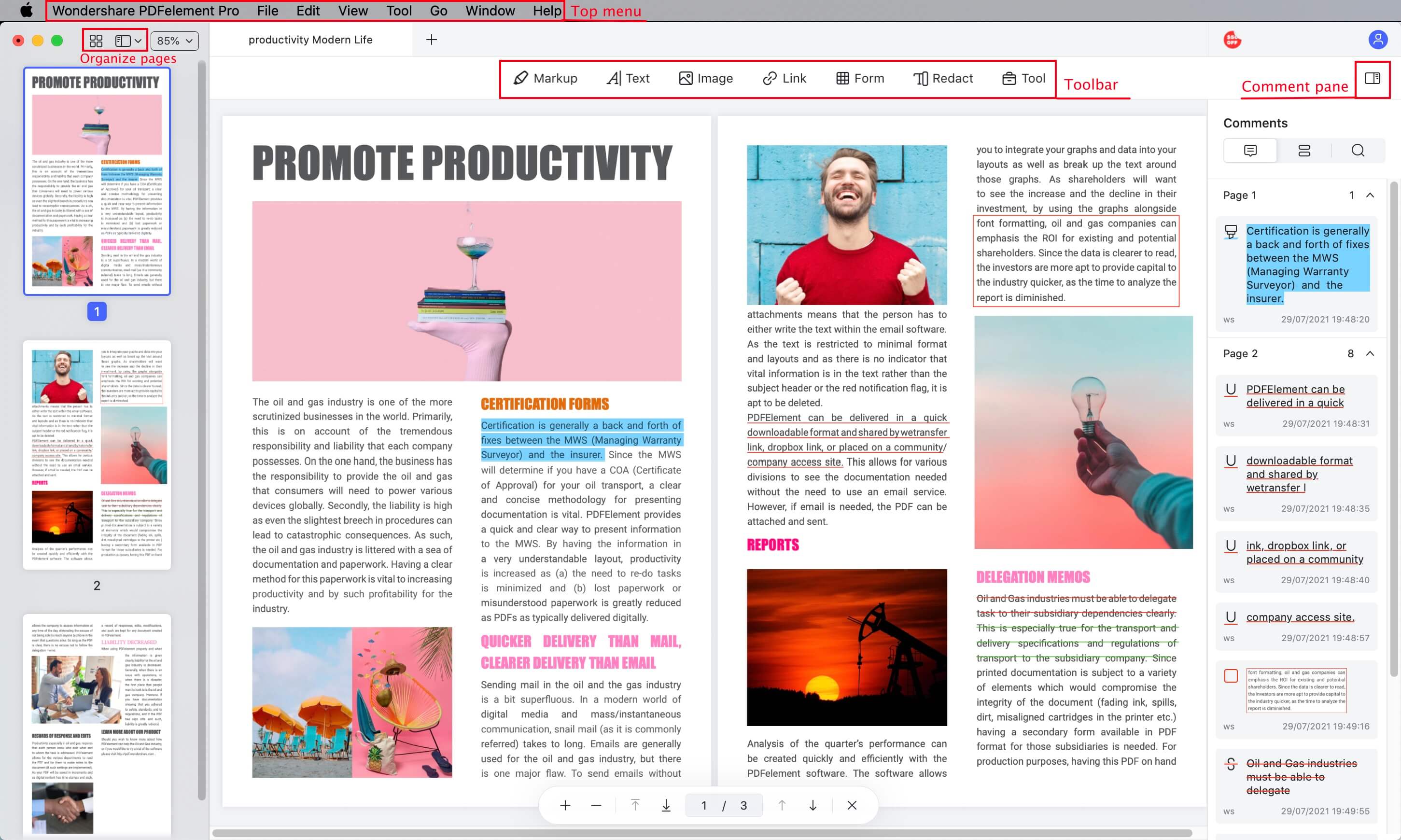
Download and Install
1System Requirements
- Operating System: Mac OS X 10.12 (Sierra), 10.11 (El Capitan) and 10.10 (Yosemite).
- Processor: 1Ghz Processor or above
- RAM: 512 MB RAM or above
- Available Hard Drive Space: 500 MB or above
- For more details, please visit: https://pdf.wondershare.com/tech-spec/pdfelement-mac.html
2Download and Install on Mac
- Visit https://pdf.wondershare.com/pdfelement.html to download the trial version of Wondershare PDFelement for Mac.
- The downloaded .dmg file will now be found in your Downloads folder. Double-clicking this file will start the installation and it will be sent to your Application folder automatically. When you need to use the program you can just access your Application folder, or from your Launchapad on the taskbar.
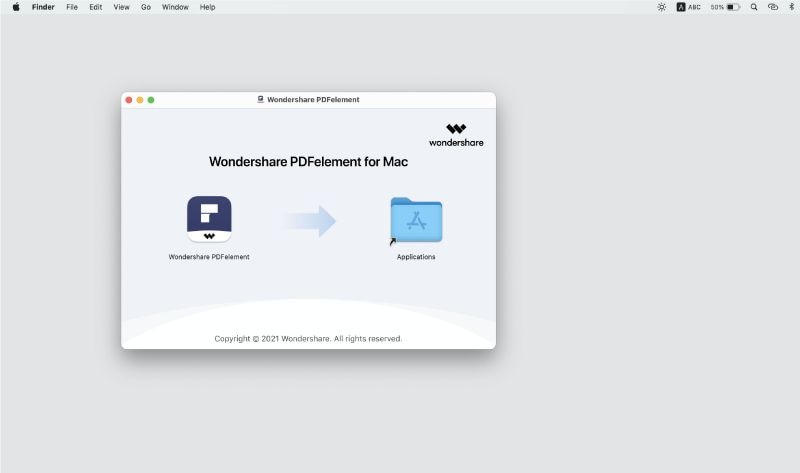
Register (Remove Trial Watermark)
1Trial Version Limitations
- Leaves a watermark on your PDF files when you save after editing or commenting on the file. (It is better if you click the "File">"Save As" button on the top menu to save it to a new copy with the watermark, then it won't affect your original PDF.)
- Convert half of your PDF pages only and convert 5 pages at most when your PDF file has more than 10 pages.
- If you use the batch process to extract data, it will process two files only.
- If you use the batch process to add a watermark or bates number, it will process all the files you load but will still add the trial watermark in each file.
- The OCR function is not available.
2Purchase PDFelement for Mac
- Click the “Buy Now” button in the program, or visit the Official Wondershare store via this link: purchase page .
- Follow the on-screen instructions to finish the purchase process.
-
Check in the email address that you supplied in your purchase as the registration information will be sent to you there.
(Note: Sometimes, you may find the registration email located in the junk/spam mail box.)
3Register PDFelement for Mac
- Please go to the Application folder to launch PDFelement for Mac. Open one file and click the "Person" icon at the left bottom side of the program window to open the login window.
- Log in with your Wondershare ID account to activate the software. If it informs you that you still do not have an account, please click "Sign Up" to create an account with the email you used to purchase the license. It will show your account information after login.
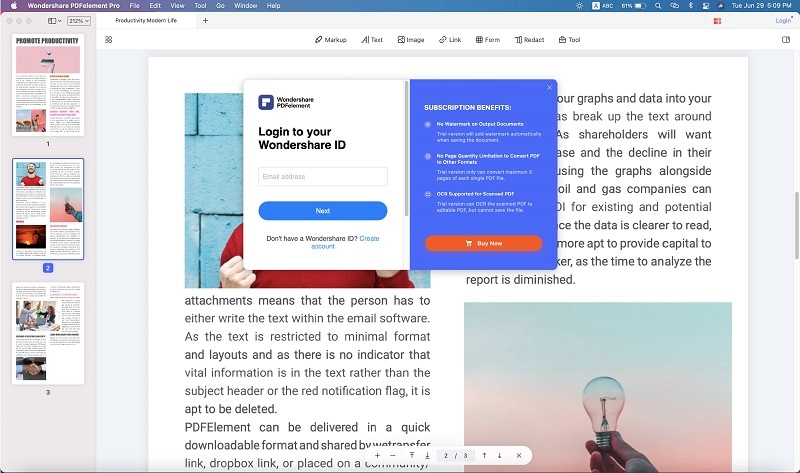
Video of how to register PDFelement
4Remove Trial Watermark
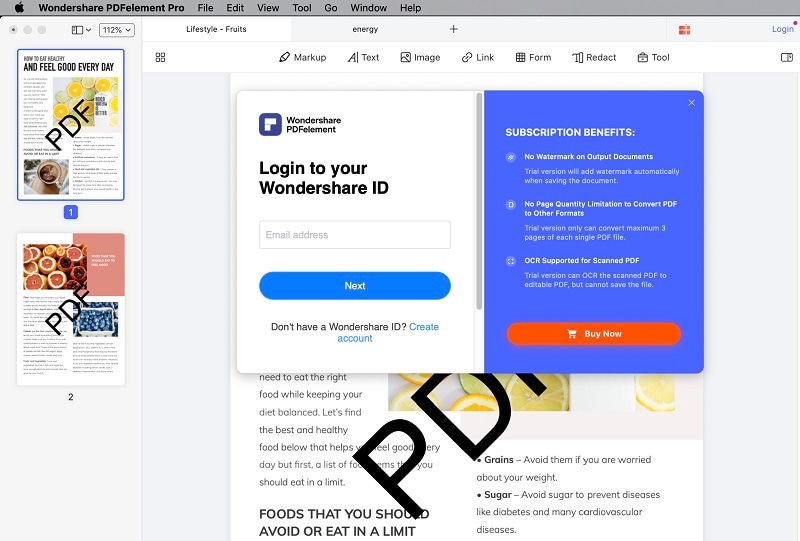
Top Menu
1File Menu

- Open: Open PDF files by browsing local folders or open the recently opened files.
- Open Recent: Open a PDF file that you have recently opened.
- Close Windows/Tab/All: Close the Windows you choose and go back to the welcome interface.
- Create: Create PDF from multiple options, including creating from file, from window capture, from selection capture, from Screen Capture.
- Save: Save PDF documents to the destination folder.
- Save As: Save the current PDF document to a new copy in the destination folder you select.
- Save As others: Choose Save as flatten, Optimized PDF or Archivable PDF(PDF/A-2b) according to your requirement.
- Export To: Convert PDF files to various other format files, such as Word, Excel, PowerPoint, image, epub, txt, html, and rtf.
- Protect To: Protect your files with a password. There are three options under this button: Encrypt with Password, Remove Security and Security Properties.
- Show in Finder: Find the destination of the file.
- Properties: Check the current PDF document descriptions, file details, and security.
- Share: Share your files Via Mail, Messages, AirDrop, Notes, Add People, or more.
- Print: Print the current PDF to paper documents.
2PDFelement Menu
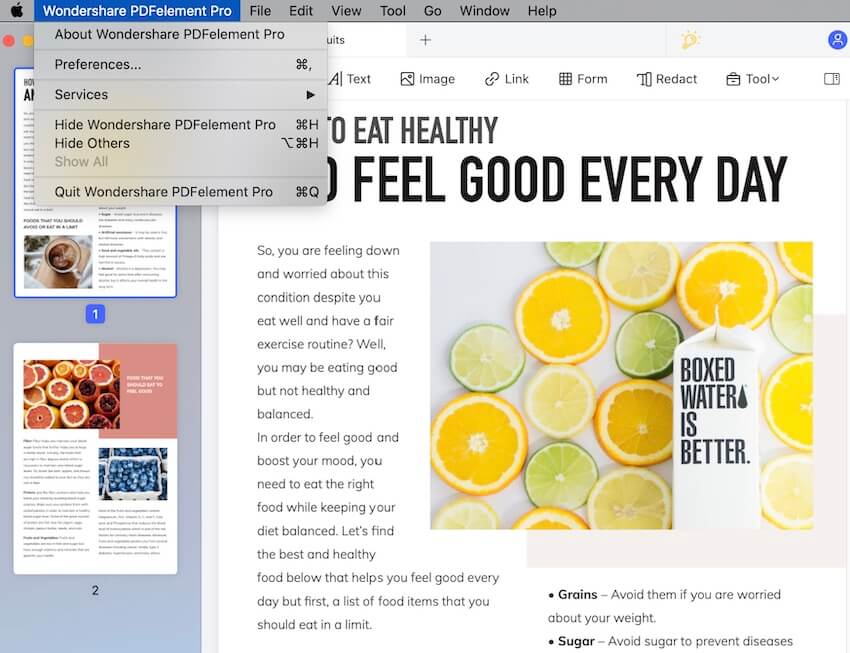
- About PDFelement: Check the version number of PDFelement for Mac.
- Preferences: Set preference options for PDFelement for Mac, including page display mode, OCR download, and OCR setting.
Search Feature
- Click the "Help" on the top menu and you will see the search box.
- Type a feature or the content you are looking for. If the feature you need is in the top menu, the resulting search will be presented under the search box with the location you need.
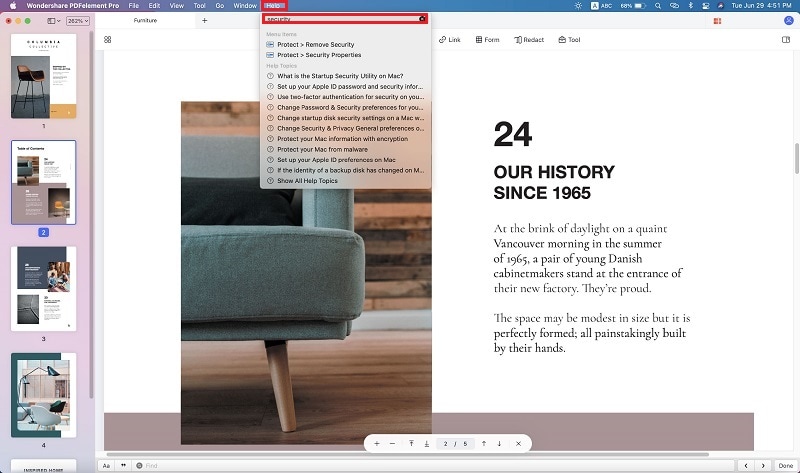
Different Ways to Open PDF
- After opening PDFelement for Mac, please drag and drop your PDF file in the product window. The PDF file will be subsequently opened.
- Click the "Open File" button at the bottom middle corner and browse your computer to open a PDF file.
- Go to "File" > "Open" or "Open Recent" on the top menu to open new or recent PDF files.
- Control the PDF file and right click to choose "Open With", then select PDFelement to open.
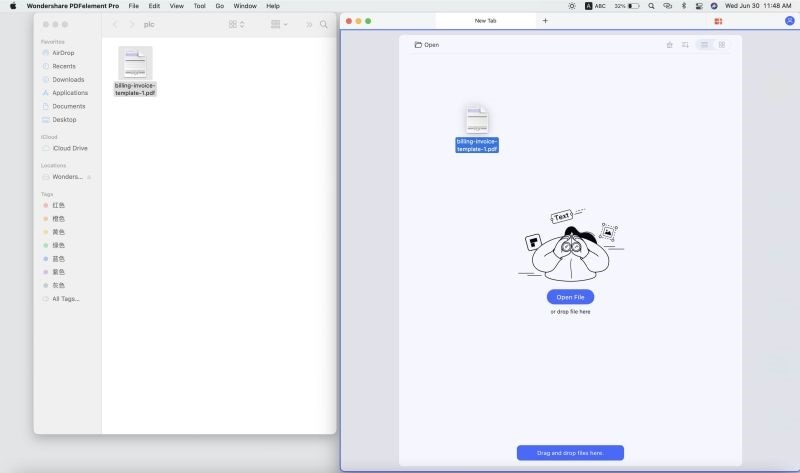
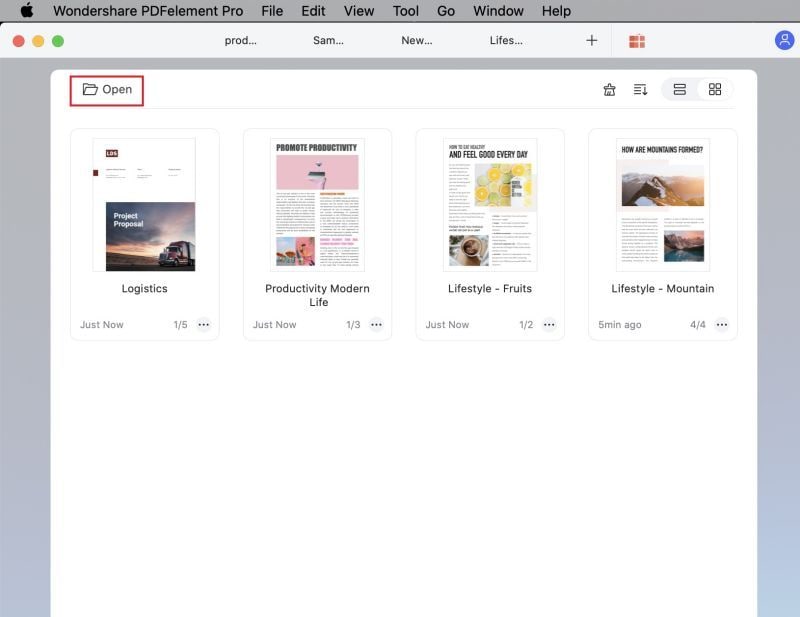
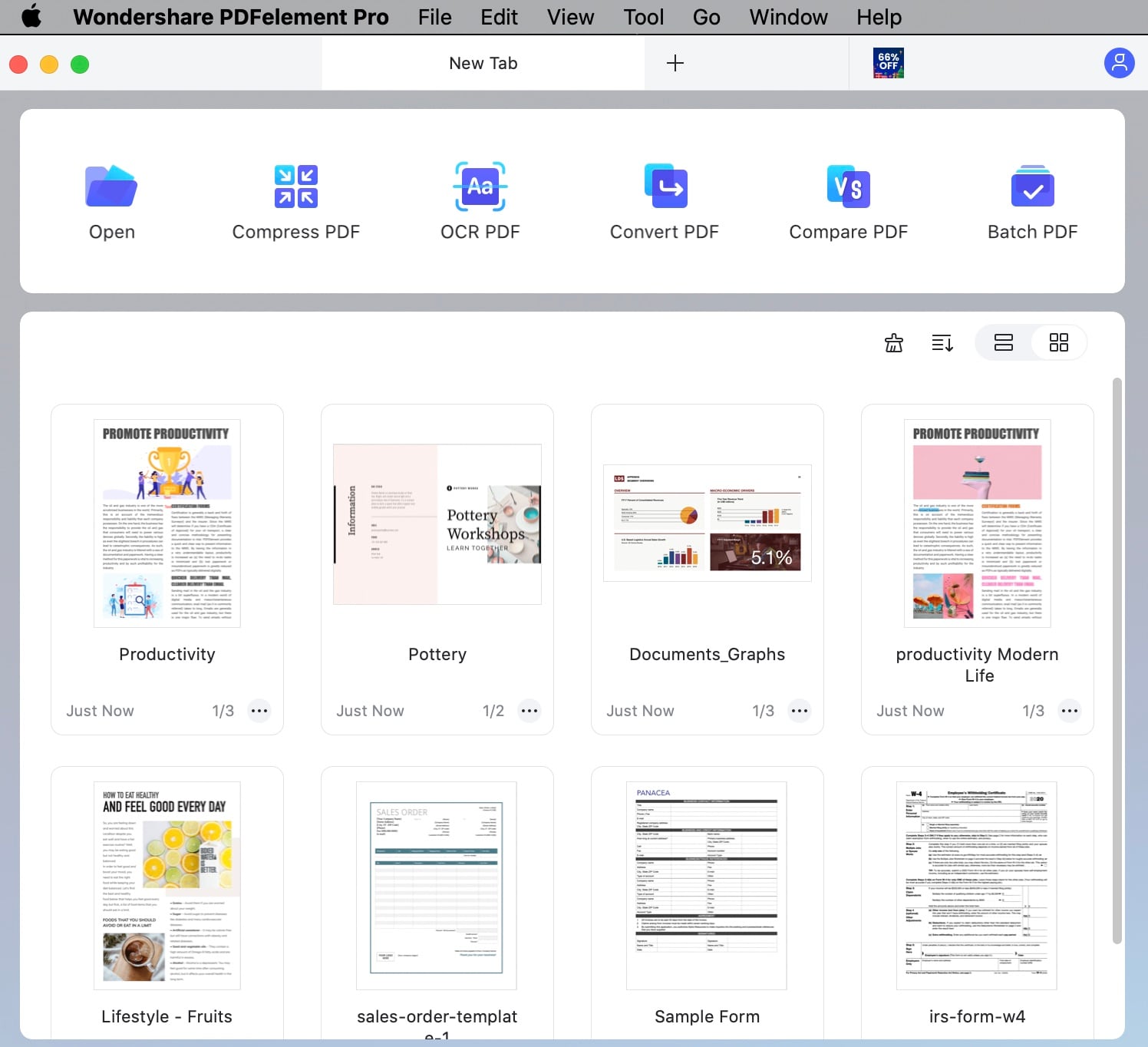
Open a Secured PDF
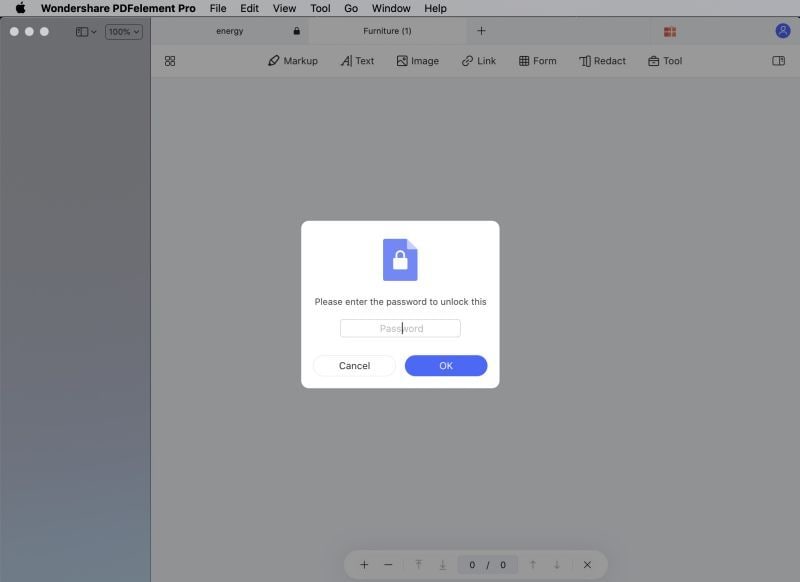
Some protected PDF files have other restrictions to prevent from printing, editing, copying, etc. When you try to print or edit this secured PDF file, you will be notified that the document is password protected. You can click the "Enter Password" button in the blue highlighted notice to enter the permission password to enable the ability to edit the document.
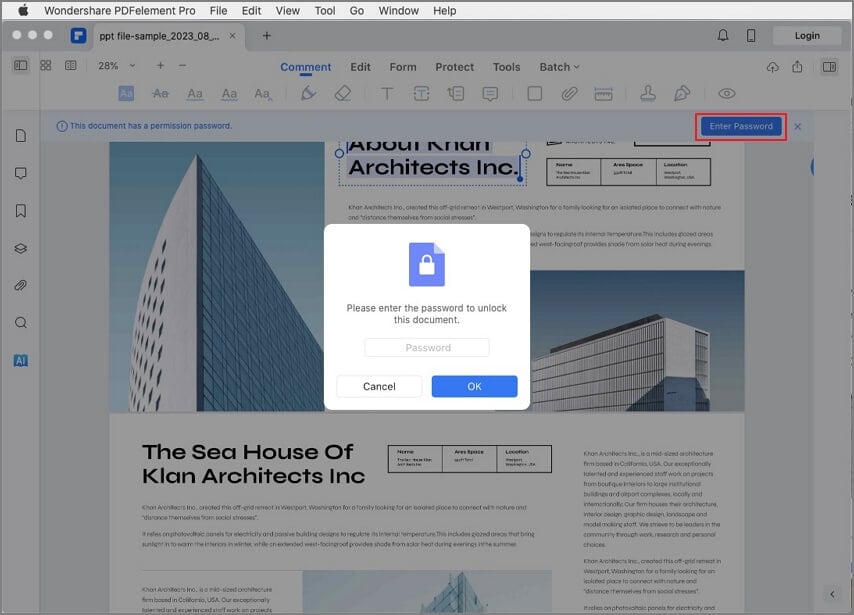
Page View Mode
1Document Layout
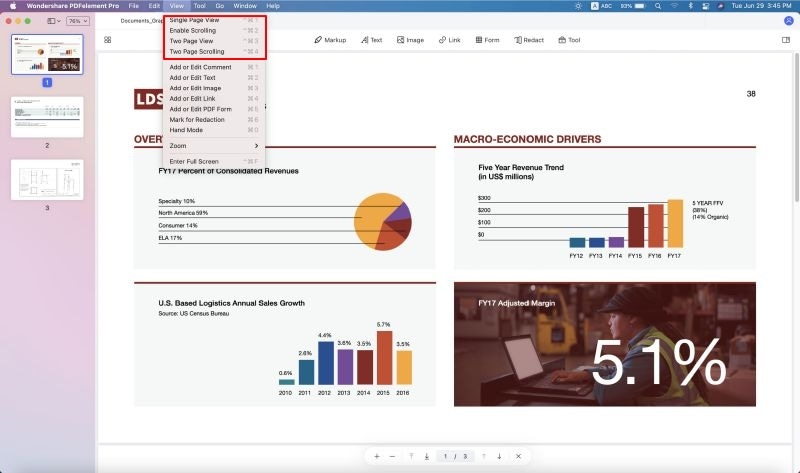
- Single Page View: View one page in the document pane at a time.
- Enable Scrolling: Arrange the pages in the document pane in a continuous vertical column with scrolling enabled.
- Two Page View: Arrange the pages side by side, displaying only two pages at a time.
- Two Page Scrolling: Arrange the pages side by side in a continuous vertical column with scrolling enabled.
2Zoom
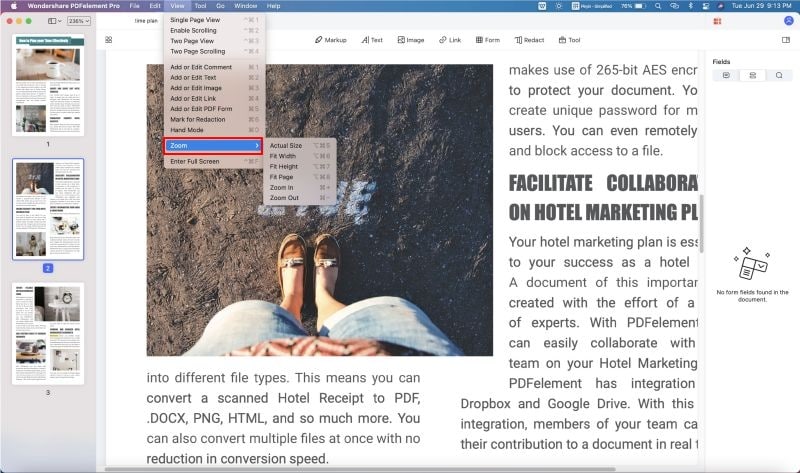
- Click the "Zoom In" or "Zoom Out" options under the "View" button or at the right bottom column, and the page will change accordingly.
3Page Layout
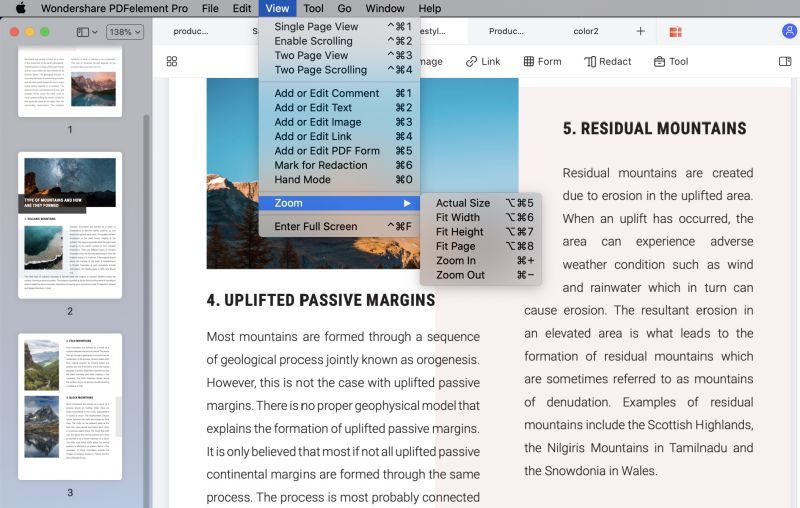
- "Actual Size": To resize the page to its actual size of 100% zoom level.
- "Fit Width": To resize the page to fit the width of the window. Part of the page may be out of the view.
- "Fit Height": To resize the page to fit the height of the window. Part of the page may be out of the view.
- "Fit Page": To resize the page to fit entirely in the document pane.
4Multi-Windows Viewing

Video of How to View PDF
Page Navigation

- Click the "Go" > "Up" button to move up from the current place.
- Click the "Go" > "Down" button to move down from the current place.
- Click the "Go" > "Previous Page" button to jump from the current page to the previous page.
- Click the "Go" > "Next Page" button to jump from the current page to the next page.
- Click the "Go" > "First Page" button to jump from the current page to the first page directly.
- Click the "Go" > "last Page" button to jump from the current page to the last page directly.
- Click the "go" > "Go to Page", enter the page number and press the "enter" on the keyboard to jump to the destination page.
- You can also use the arrow keys in your keyboard to go up or go down for scrolling pages.
Navigation Panel
1Display Navigation Panel

2Thumbnail Panel
- Organize the page order: by dragging the thumbnails in the "Thumbnail Panel", you can reset the order for your pages as you need.
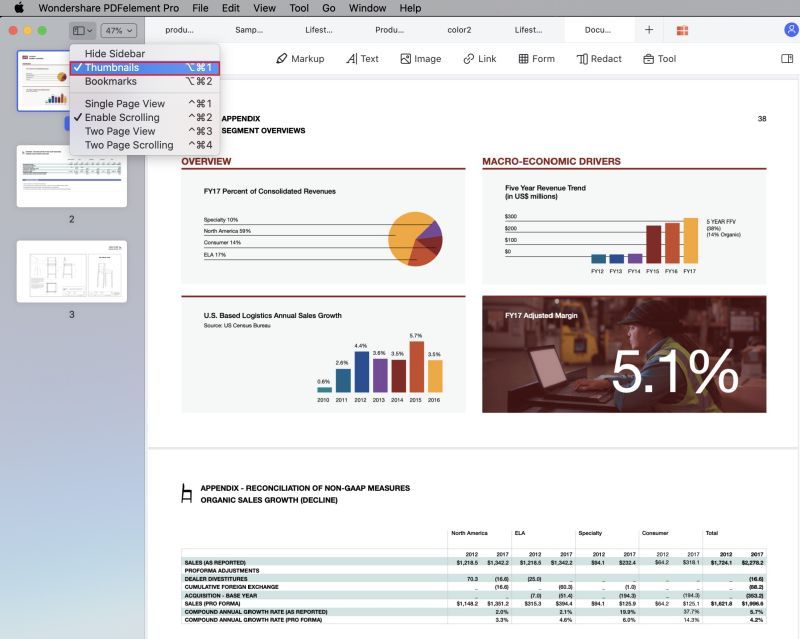
3Bookmark Panel

4Comment Panel
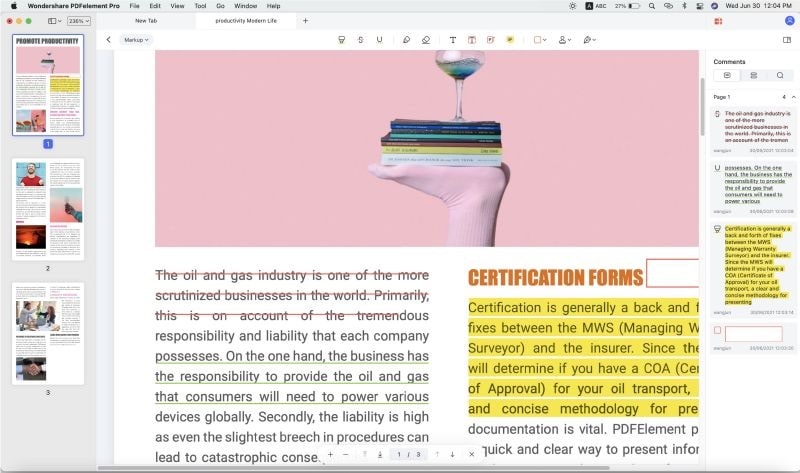
Create in PDFelement Window
1Create a PDF from a File
- Click "File" > "Create" > "PDF from File". Open the file by browsing to a local folder, then make your modification once the file has opened in PDFelement for Mac, then click "Save" to save it into your preferred destination folder.
- Navigate the file you would like to create to PDF in the popup window and click "Open". Note: If you select multiple files to create, it will open each file in a separate window so that you can save each as a separate PDF file.
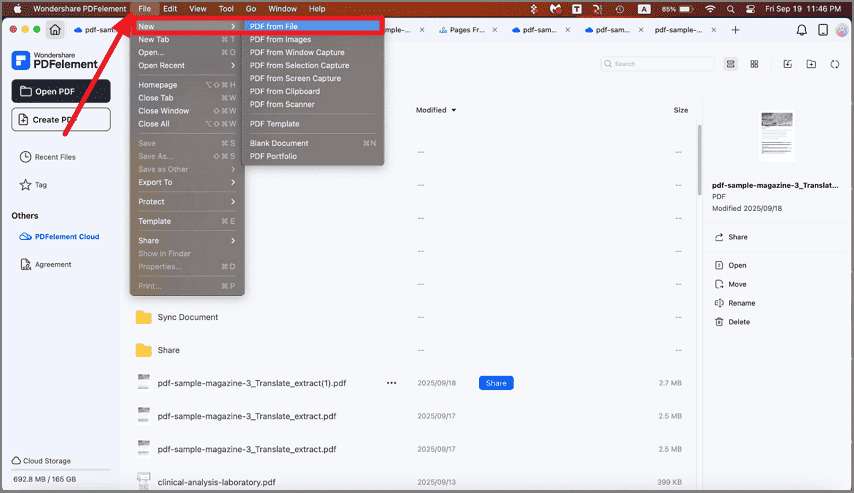
2Create a PDF from Capture
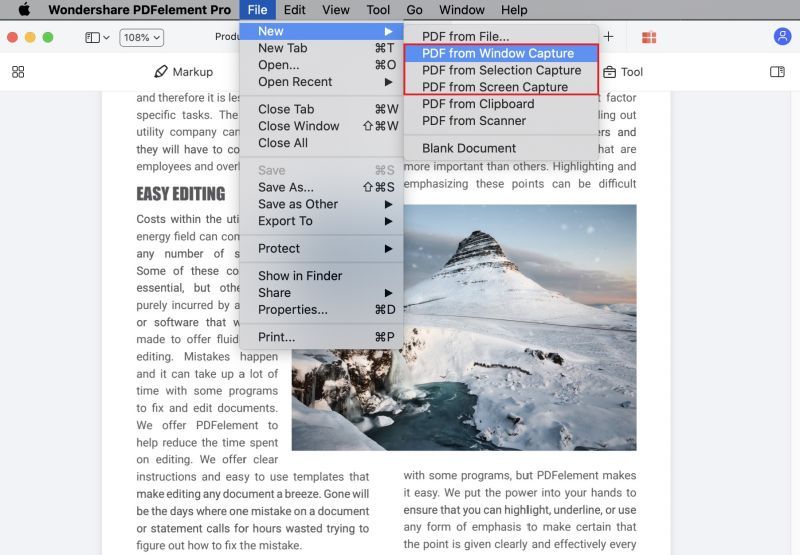
- PDF from Window Capture: Create PDF from any window that you have opened on the desktop.
- PDF from Selection Capture: Use selection tools to create a PDF from an area that is defined by you.
- PDF from Screen Capture: Create a PDF using the full-screen information.
3Create a PDF from Blank Document
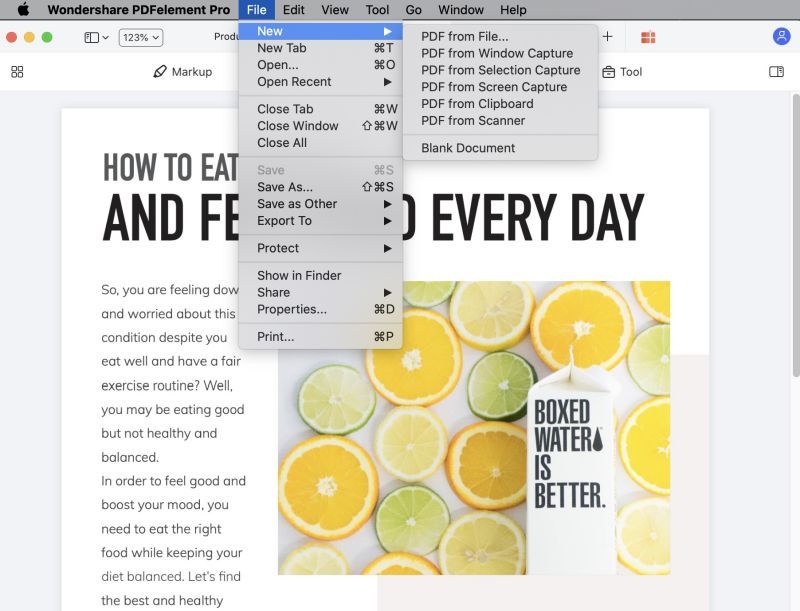
- Click "File" > "Create" > "Blank Document", it will popup the output place for you to choose. Click "Save" after choosing the output place, a blank document is created successfully.
4Create a PDF from Scanner
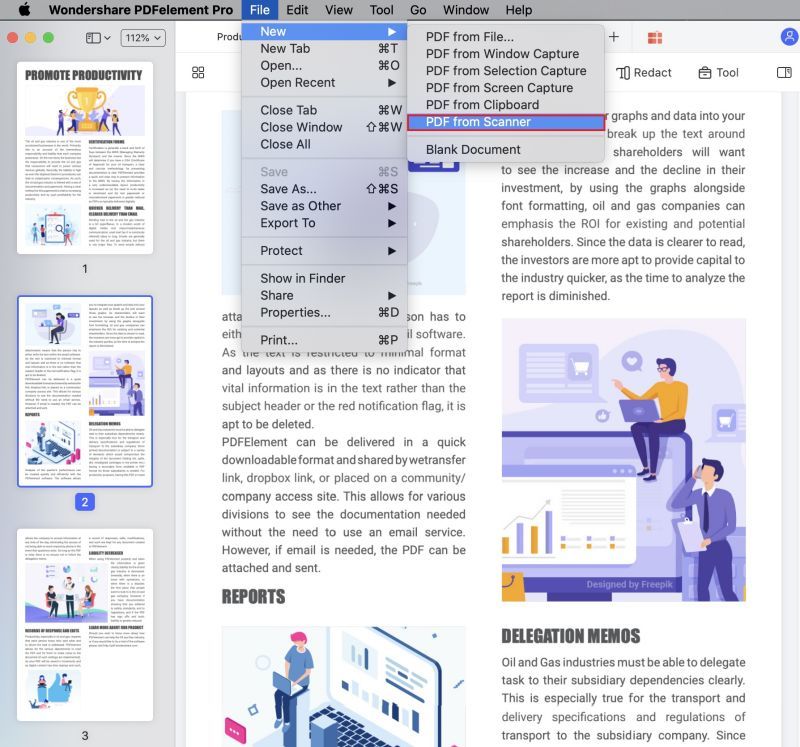
- Simply click the "File">"Create">"PDF from Scanner" button on the top menu (Home menu) on your Mac. Doing this will automatically activate the "Create from Scanner" feature.
Edit Texts
1Edit Text
- Select the "Text" button at the left side column, then click the desired text, and the cursor will appear in the text box allowing you to enter new text, and change what you already have.
- You can choose "Paragraph mode" or "Line mode" at the top column of program windows to edit.
- Choose the font, size, layout, and color, etc. as you need for the text or paragraph.
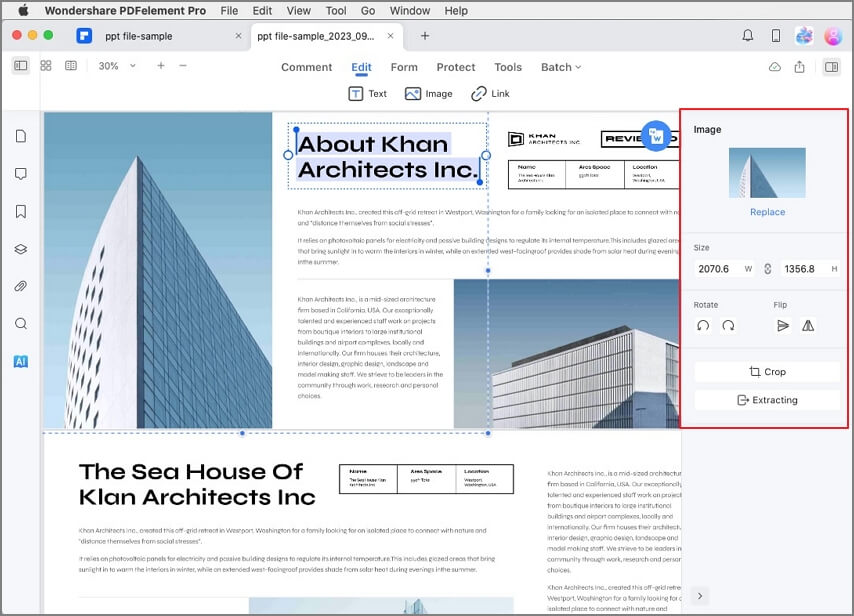
2Add Text
- After clicking the "Text" button, click the "Add Text" tool at the top column of program windows to insert new text into the existing PDF document.
- Click the page where you wish to place the new text. An input box will appear for adding text.
- Select the font, size, layout, and color, etc. as you want for the text or paragraph.
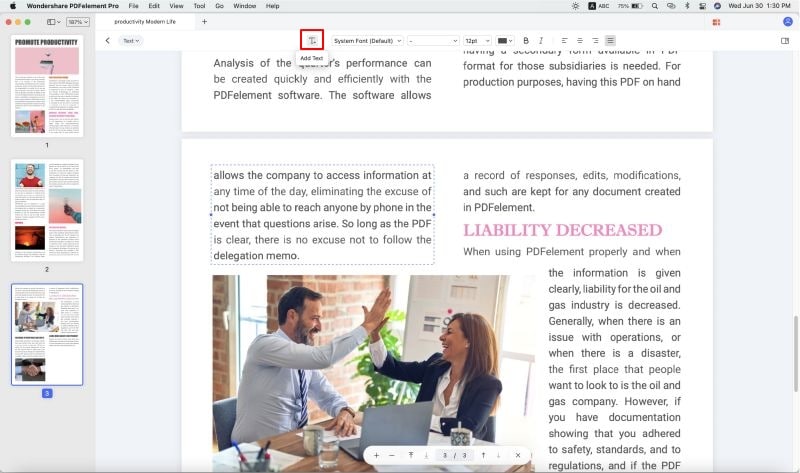
Video of Editing Texts
Edit Images
1Add Image
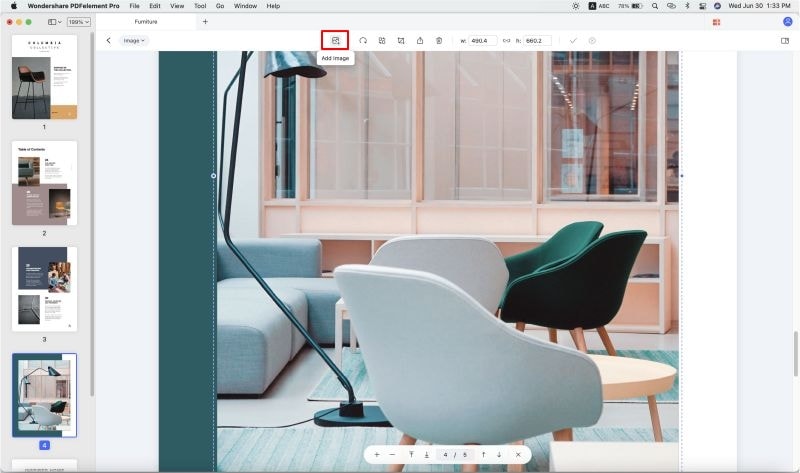
- Click the "Image" button in the toolbar, and then click the "Add Image" button at the top column of program windows.
- Select the image from your computer insert directly.
- Click and hold on one of the eight small blue boxes on the edge to resize as needed.
- To move the image as needed, click and drag the image to the location required. Using the arrow keys on the keyboard will allow for precise movements of the images.
2Delete Image
3Copy/Paste Image
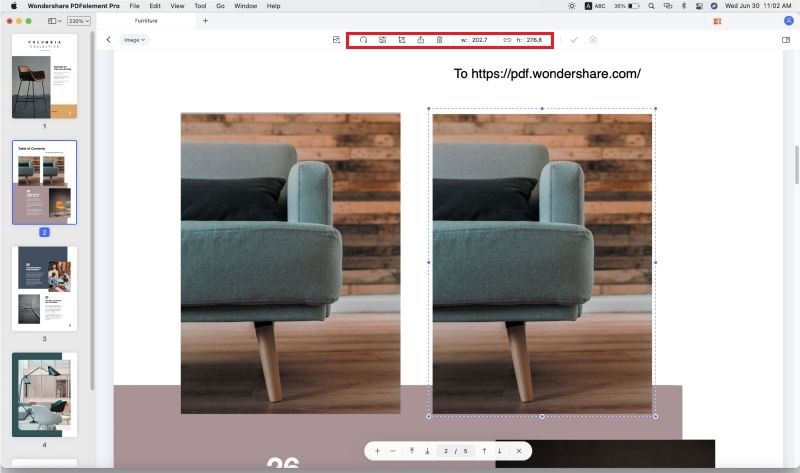
4 Rotate/Replace/Extract/Crop Image
- Hit the "Image" button at the left column to start editing mode, then click the target image.
- At the top column, you can rotate the image, replace, extract or crop it.
- Rotate: Change the orientation of the selected image.
- Replace: Select a new image as a substitution to the target one.
- Extract: Take the target image out from the current PDF.
- Crop: Adjust the image to only show the important aspects of the document.

Video of Adding Image
Link
1Add Link
- Click "Link" at the left column. And all options will appear at the top column of program windows.
- Click on the location in the document that you wish to place the link.
- On the top column, You can choose Go to a page view or Open a web page Go to a page view: After choosing this option, find the place you need to add the link, hold on the mouse and slide to a rectangle, then you will get a message window, just choose to the correct page, then click the "Save" button to set.Open a web page: After choosing this option, please enter the website link in the popup box.
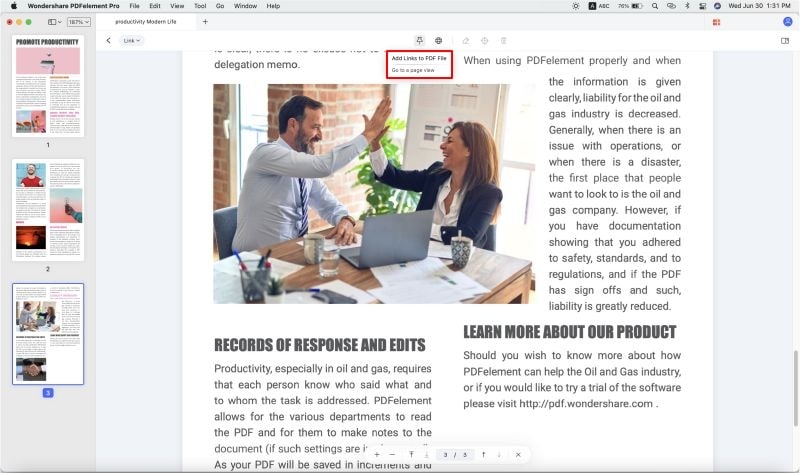
2Edit/Delete Link
PDF Watermarks
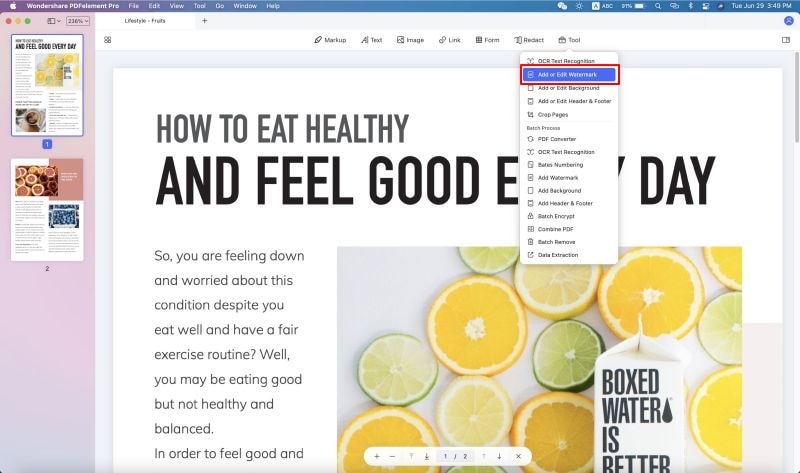
1Add Watermark to a Single PDF
- After opening a PDF file in the program, click the "Tool" > "Add or Edit Watermark" > "Add Watermark" button at the left column.
- Click "Create" at the right-side panel and choose "Text", "Image" or "PDF" to add watermark. Text: Enter the text in the box below as the watermark. Adjust the font type, size, color, position, etc, for it. Image: Click the "..." button to select an image on your Mac as the watermark and you can change its appearance and position. PDF: Click the "..." button to select a PDF file, enter the page number to select a specific page as watermark and you can change your appearance and position per your requirement. You can click the "Apply" button at the left side panel after you finish editing the watermark to apply the watermark to your file.
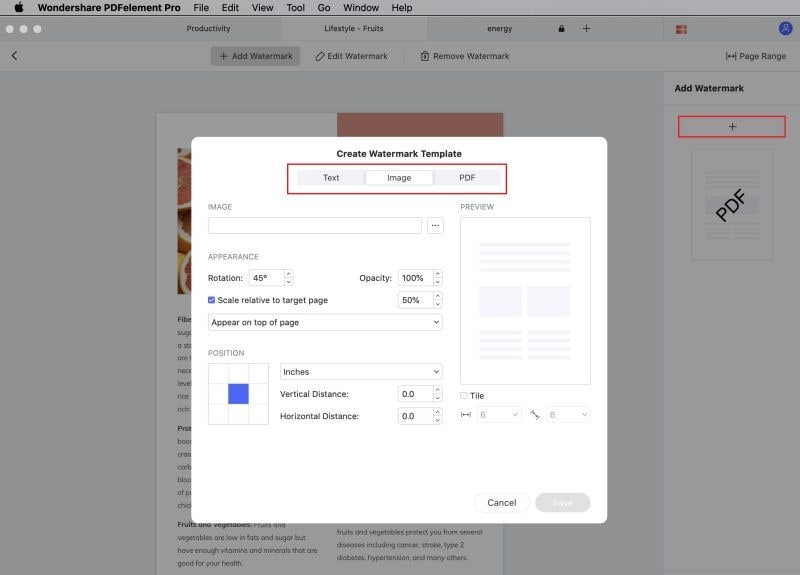
2Delete Watermark on PDF Pages
- Go to the "Tool" > "Add or Edit Watermark" > "Edit Watermark". You can find the "delete" button on the right column after putting your cursor on the watermark file. Click and delete it.
- Click "Yes" in the popup window and click "Apply" at the left column to remove the watermark.

3Batch Watermark Process (Only available in PDFelement Pro for Mac version)
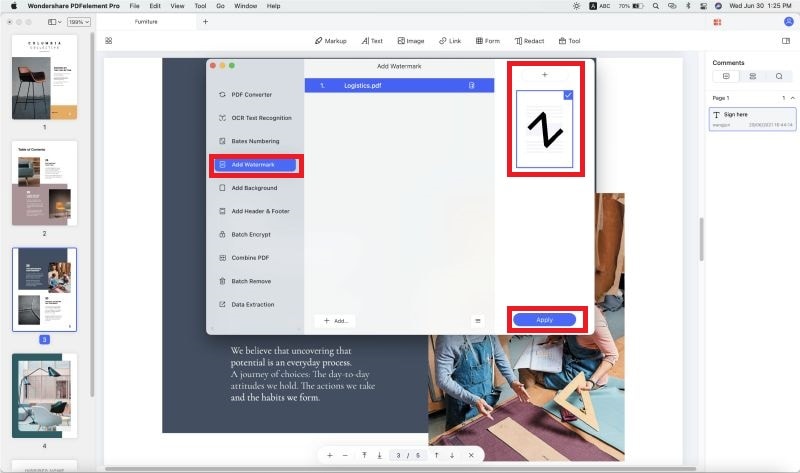
- Batch to add watermark:
- After opening one file in the program, click the "Tool" > "Batch Process".
- Click the "Add Watermark" button, then load multiple PDF files in the program through drag and drop, or choosing the files from the finder.
- Choose one watermark on the right side. Or click the "+" button to create a watermark template as your requirement.
- Then select the output folder to save the output files.
- Batch to delete watermark:
- After opening one file in the program, click the "Tool" > "Batch Process".
- Click the "Batch Remove" button, then load multiple PDF files in the program through drag and drop, or choosing the files from the finder.
- Choose "Watermark" at the right side..
- Then select the output folder to save the output files. All watermarks will be removed.
Video of How to Add and Remove PDF Watermark
PDF Background
1Add Background to PDF Pages
- Go to the "Tool" > "Add or Edit Background" > "Add Background" button in the toolbar.
- Click "Create" in the right column. Select the "Color", "Image" or "PDF" in the option of the popup box. Color: Choose the color as you wish from the ones listed. Image: Click the "..." button to select an image on your Mac to add as background. You can set its appearance and position. PDF: Click the "..." button to select a PDF on your Mac, set the specific page as the background. You can set its appearance and position. Click "Apply" after you finish editing to save the modification.
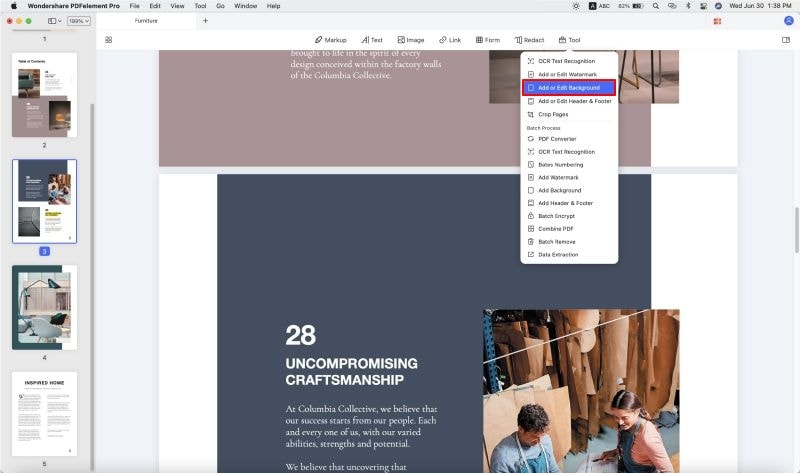
2Remove Background
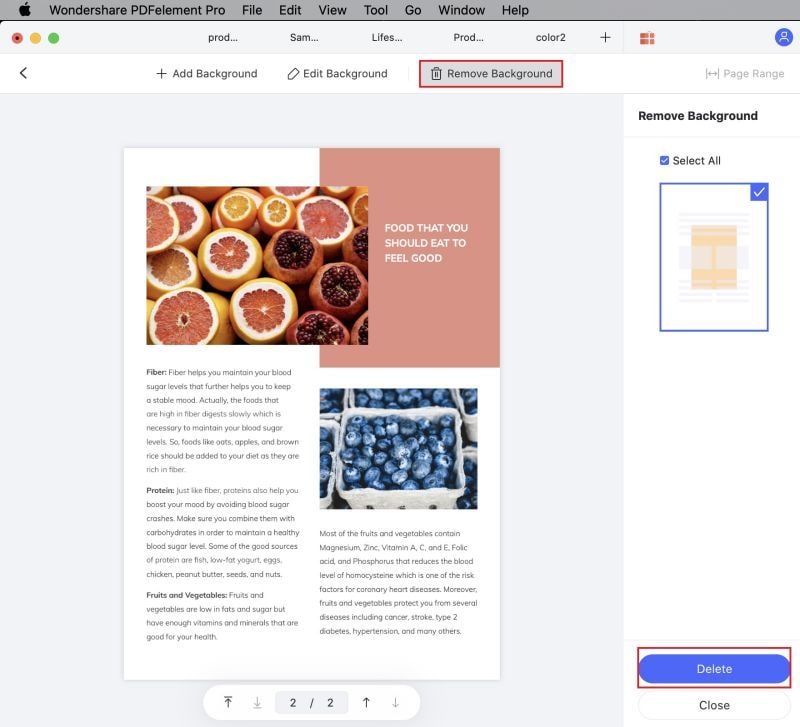
3 Batch to add and Remove Background
Video of How to Add Background to a PDF
PDF Header & Footer
1Add Headers & Footers
- Please go to "Tool" > "Add or Edit Header & Footer" > "Add Header & Footer" button in the toolbar.
- Click the "Create" button, you can change "Layout", "Format", or "Content". Also, you can preview it there.
- After getting what you need, click the "Save" button.
- Click "Apply" to apply the Header & Footer to your file.
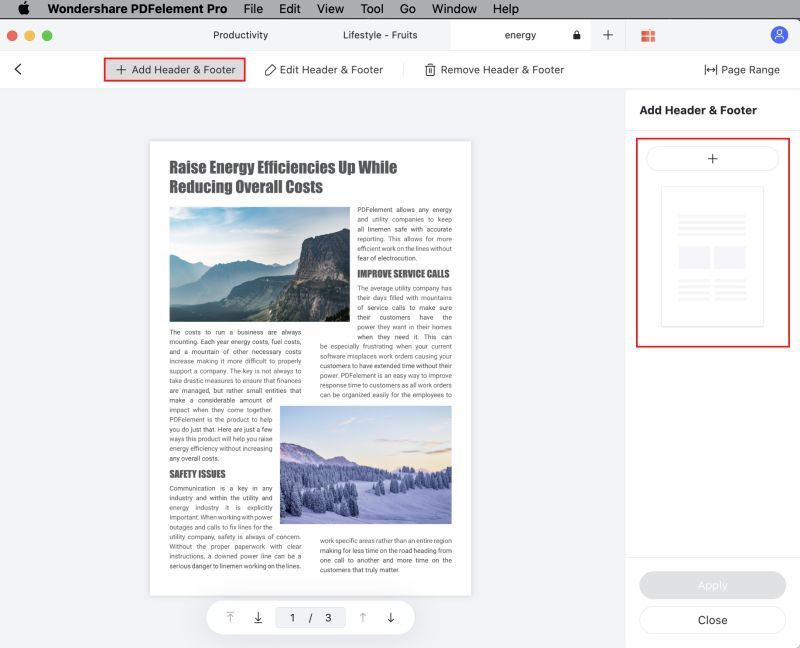
2Delete Header & Footer
- Go to the "Tool" > "Add or Edit Header & Footer" > "Edit Header & Footer" button in the toolbar.
- Putting your cursor to the Header & Footer you set at the right column, click the "delete" button below the Header & Footer file to remove it.
- Click "Apply" to remove the Header & Footer from your file.
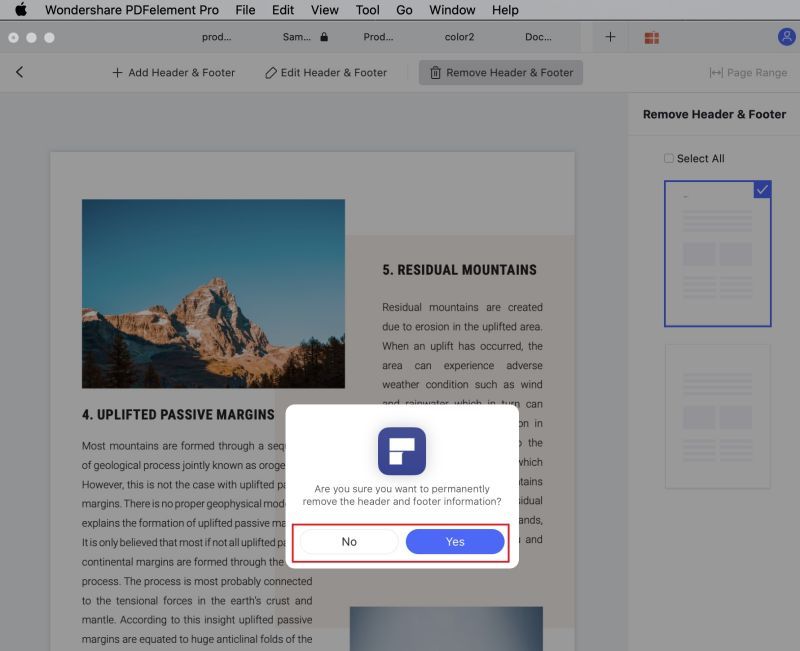
3 Batch to add and Remove Header & Footer
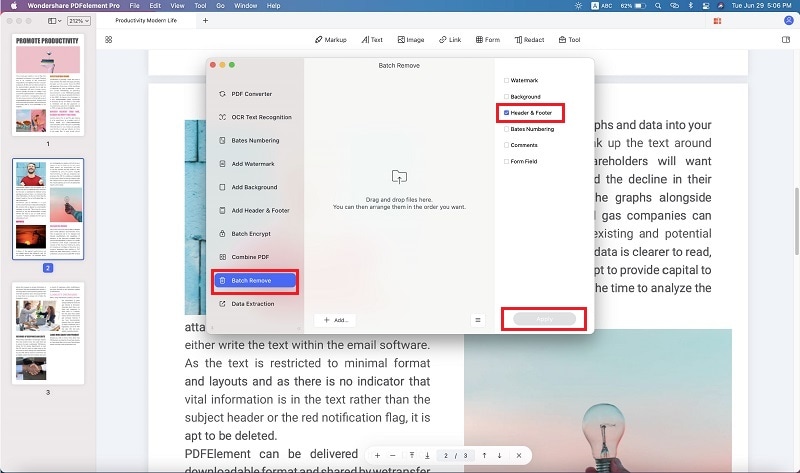
PDF Bates Numbering
(Only available in PDFelement Pro for Mac version)
1Add Bates Numbering
- Please go to "Tool" > "Bates Numbering" or "Tool" > "Batch Process" > "Bates Numbering".
- Click "Add..." to add the file you need to add bates Numbering, click "+" button.
- In the popup windows, please choose the "Insert Bates Number" button. Click "Add" after editing.
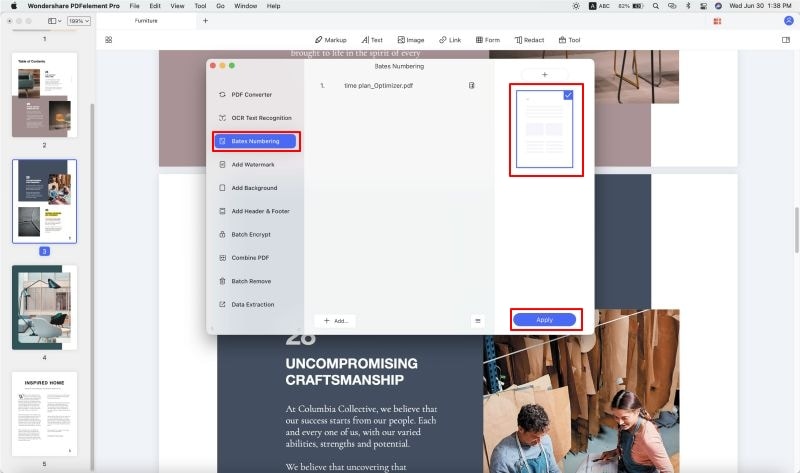
2Remove Bates Numbering

Video of How to Batch Add Bates Numbering to PDFs
What is OCR
(Only available in PDFelement Pro for Mac version)
Note: OCR function is embedded in the product PDFelement Pro for Mac, it does not need to purchase separately.
Download/Install OCR
(Only available in PDFelement Pro for Mac version)

Perform OCR for A Single Scanned PDF
(Only available in PDFelement Pro for Mac version)
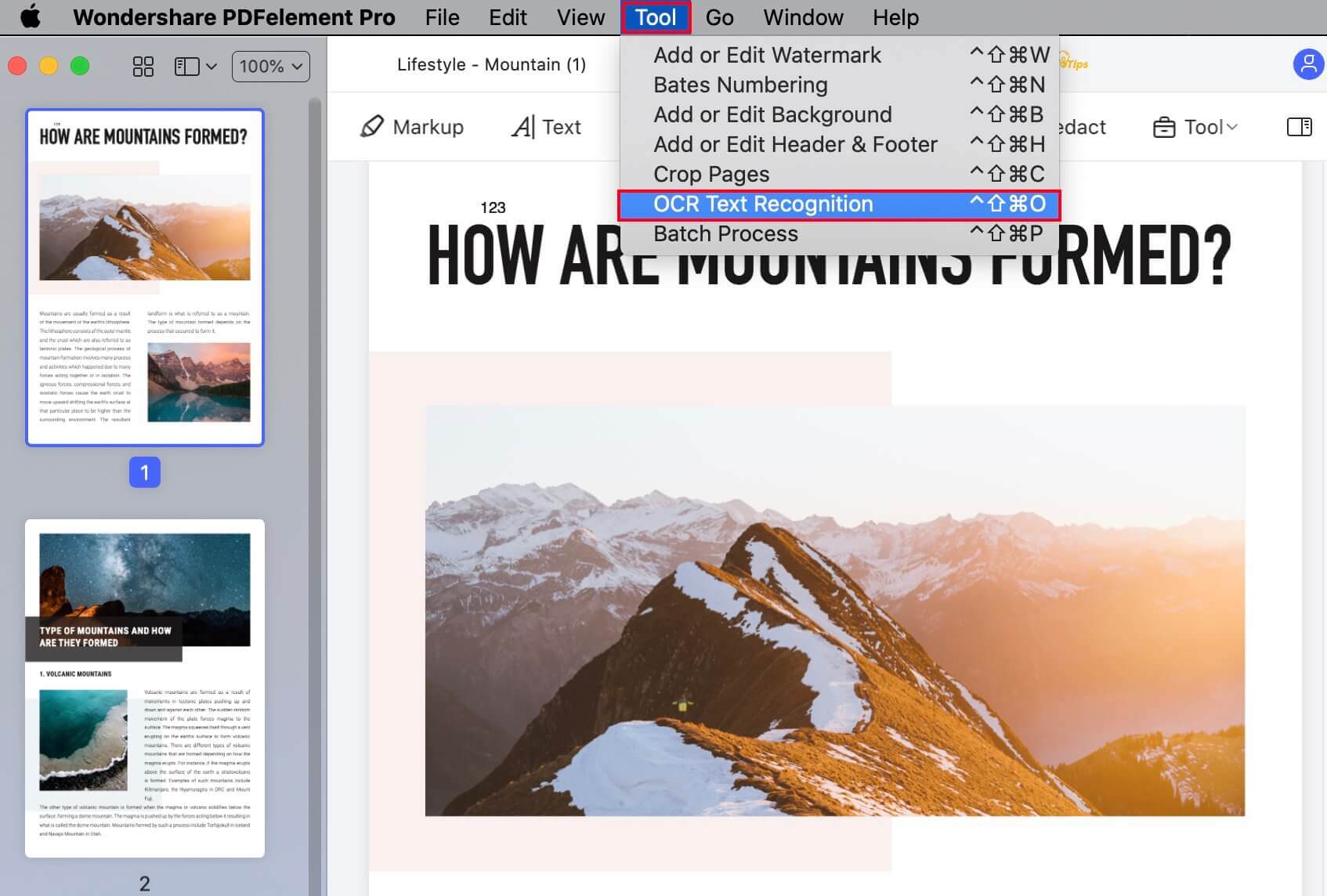
- Click “Perform OCR” in the highlight bar or "Tool" > "OCR Text Recognition" button. You can do some settings in order to make the output file have better quality or according to your file requirement.
- Click the button at the left bottom of popup windows and you can find "Page Range" and "OCR setting" options.
- By choosing "Page Range", you can choose which pages you want to perform OCR.
- By choosing "OCR Setting", you can choose document language, change dpi, and choose which type you need.
- After setting, you can click "Perform OCR" in the windows. You can edit the texts after the process is finished.
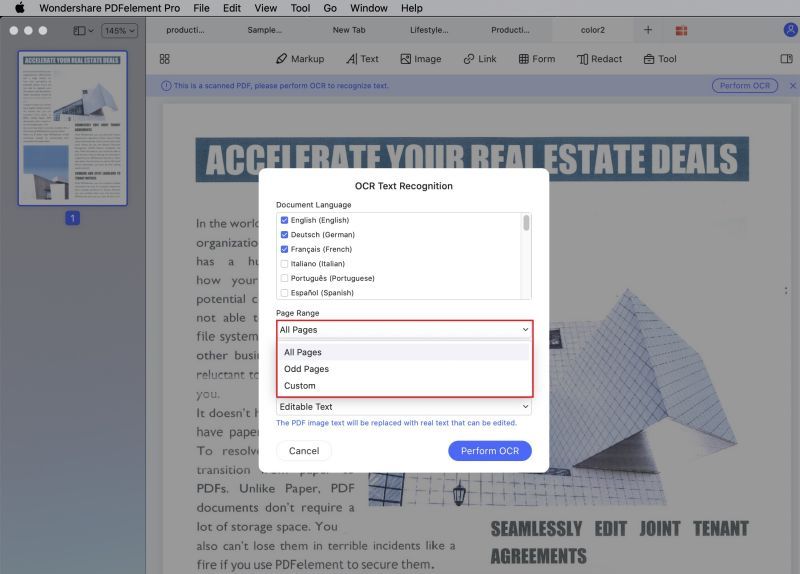
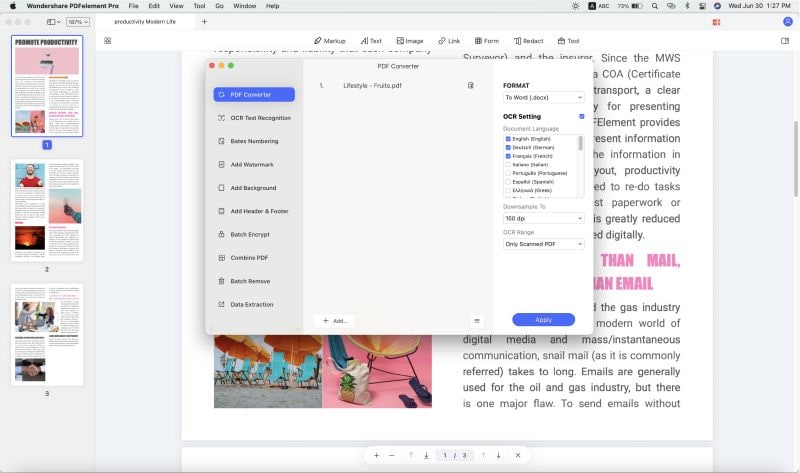
Video of Performing OCR
Batch OCR for Multiple Scanned PDFs
(Only available in PDFelement Pro for Mac version)
- Click the "Tool" > "Batch Process", then click the "OCR Text Recognition" button.
- Load multiple scanned PDF files or image-based PDF files into this window.
- Find "Document Language" to select the correct language of the PDF content in the OCR language list. You can also choose the "DPI" for your files.
- Select the "Editable Text" or "Searchable Text Image" option for your PDF files. "Searchable Text Image" will enable the PDF file to be searchable so that you can search/copy/paste the text to other documents. "Editable Text" will enable the PDF file to be editable.
- Click the "Apply" button, then select the output folder where you want to save the newly created PDF files.
- After performing OCR, you will find the new outputted PDFs saved.
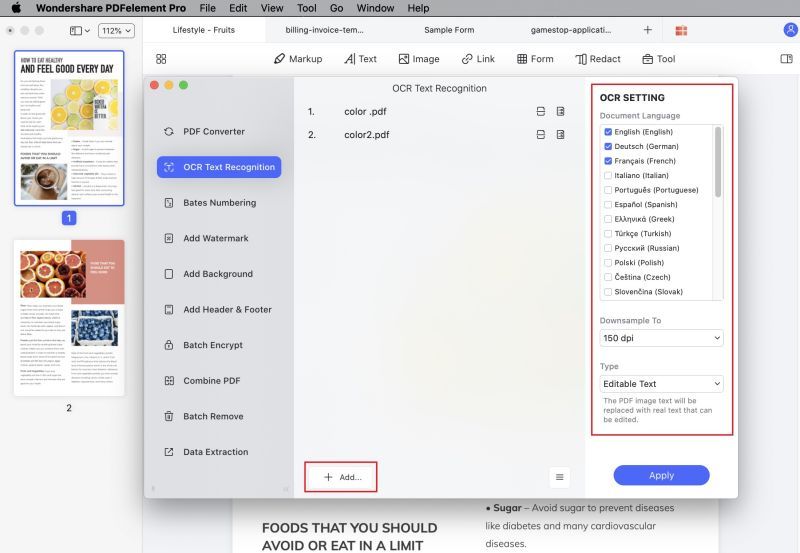
Video of How to Batch OCR PDFs
Organize Pages
1Rotate PDF Pages
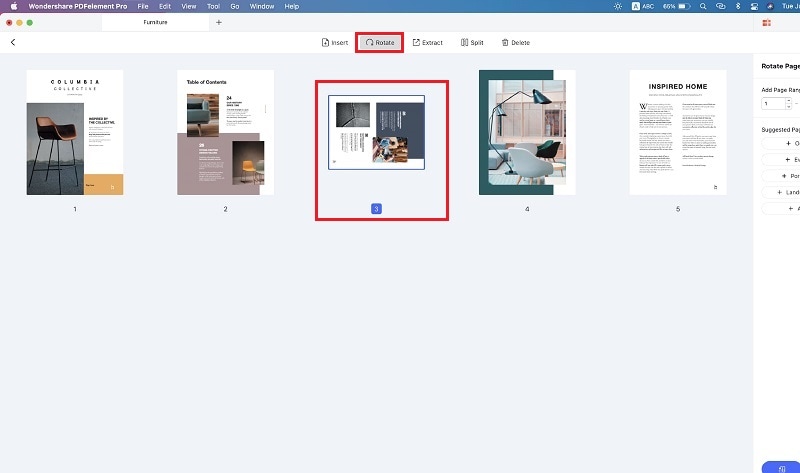
- Open one file and click the “Organize Pages” on the right side column, you will find "Rotate Pages" on the left side column.
- Click a single page or hold the Command key and click multiple pages to be selected at the same time or click "Page Range" and input which pages you need to rotate. Click the "Rotate Pages" button to rotate it.
2Delete PDF Pages

- Open one file and click the “Organize Pages” on the right column, you will find "Delete Pages" on the left side column.
- Click a single page or hold the Command key and click multiple pages to be selected at the same time or click "Page Range" and input which pages you need to rotate.
- Click the "Delete" button on the left side column to remove.
3Insert PDF Pages
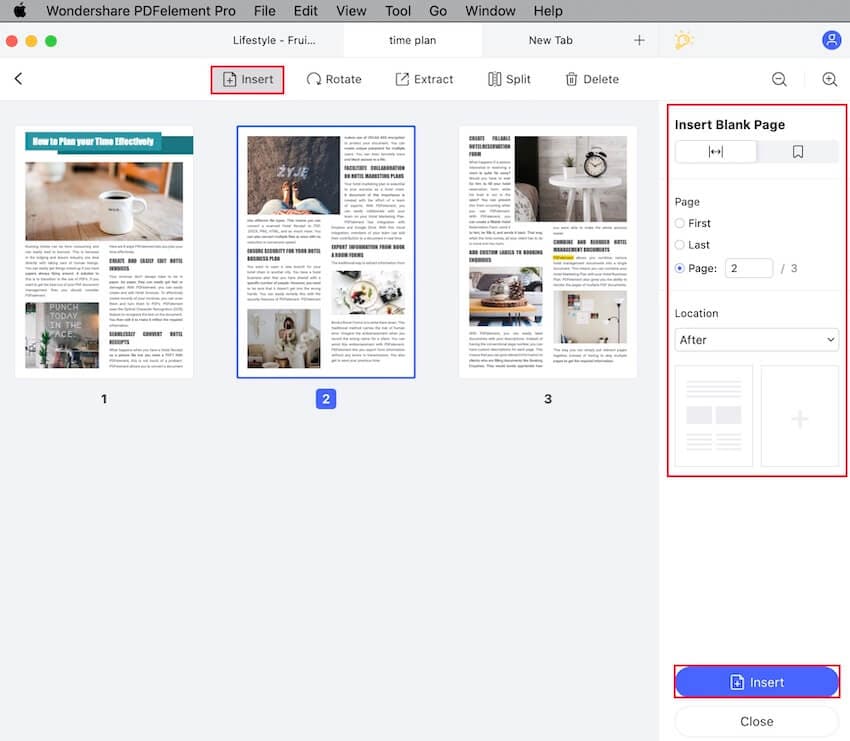
- Open one file and click the “Organize Pages” on the right column, you will find "Insert Blank Page" or "Insert from File "on the left side column.
- Browse to select another PDF file that you want to insert. Once you insert, you will insert all pages of your file. If you only need one page, you can click "Page Range" and input which pages you need to delete them.
5Extract PDF Pages
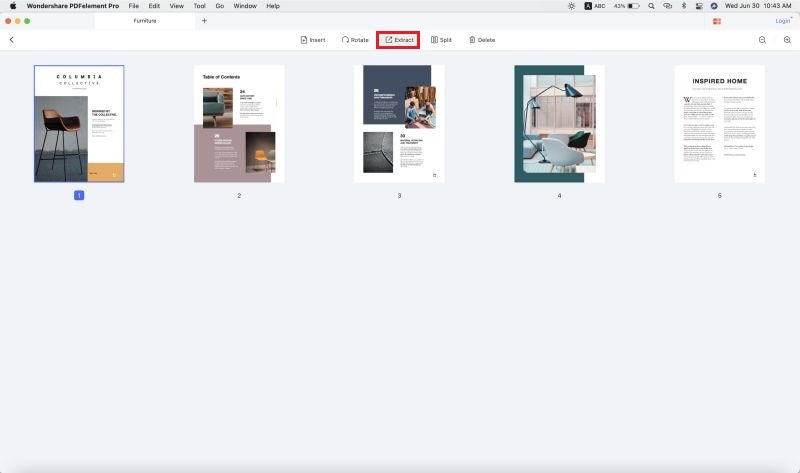
- Open one file and click the “Organize Pages” on the right column, you will find "Extract Pages" on the left side column.
- Click a single page or hold the Command key and click multiple pages to be selected at the same time.
- Click "Extract Pages" button to extract and select an output folder to save the new file.
Video of Extracting Pages
Change Page Order
- Open one file and click the “Organize Pages” on the right column, then click the page thumbnail that you want to move and drag it to the correct place in the document.
- Alternatively, you can hold the Command key and select multiple page thumbnails to allow for the movement of multiple pages at the same time, into the correct location in the document.
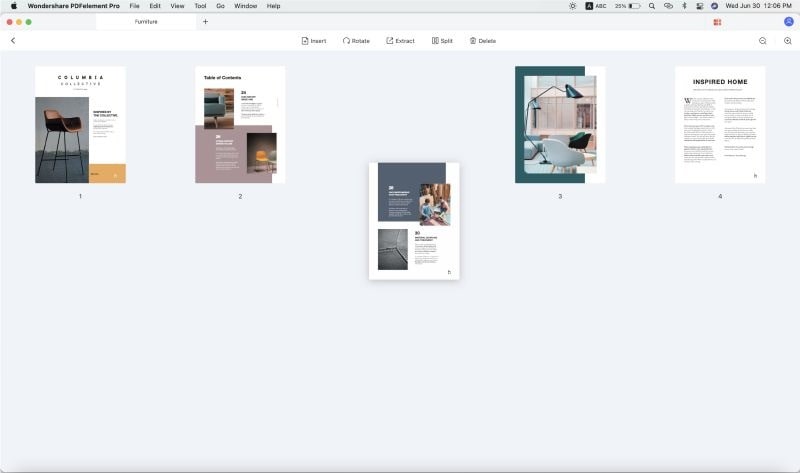
Combine Multiple Files into One PDF
- After opening the program and open one file, please click the "Tool" > "Batch Process" > "Combine PDF".
- Load all of the files that you need to combine into the program.
- Click "Apply", the output folder will be opened automatically. Choose the output folder and click "Open" and your files will be combined.
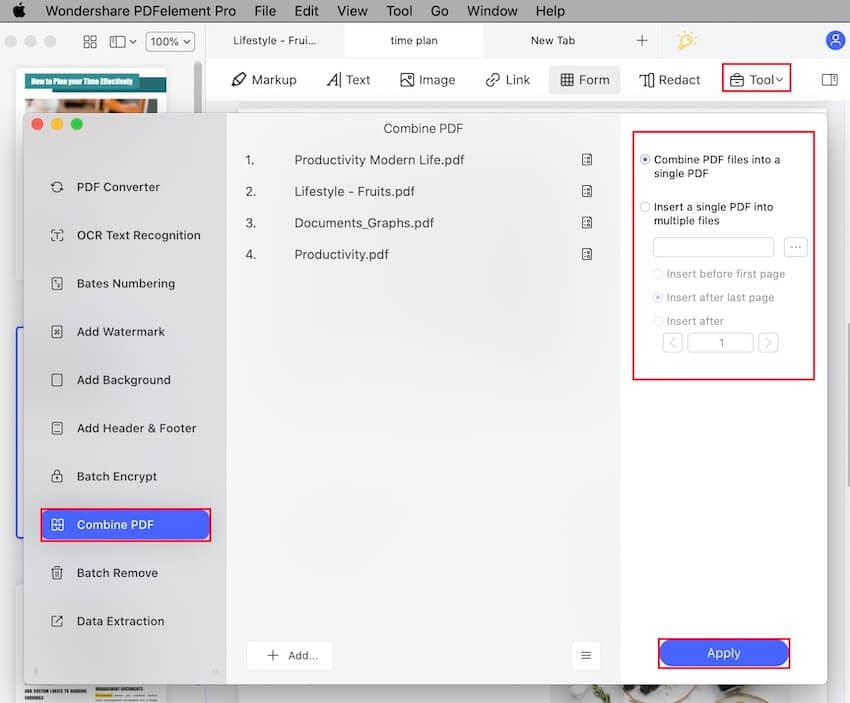
Video of Combining PDF Files into One PDF
Text Markups
- Highlight: To mark important passages of text with a fluorescent marker as a means of memory retention or for later reference.
- Strikethrough: By using the "Strikethrough" option, you indicate that the text is to be ignored or deleted.
- Underline: To indicate that there is an emphasis on the information through an underline.
1Highlight PDF Text
- After opening your PDF file in the program, please click the "Markup" > "Highlight" button.
- Select the text you need and it will be highlighted immediately. The highlight properties panel will be at the left side panel. You can choose the color as you need.

2Edit Highlight Properties
- Put your cursor on the right margin of one of the color, you will find one rectangle button. Click it. The properties windows will pop up for you to choose any color you need.

3Add Strikethrough/Underline to PDF Text
- After opening the PDF file in the program, please click the "Markup" on the left side column to get more tools.
- Then please click the "Strikethrough" or "Underline" button, select the text you need to be underlined, or have a strikethrough and the operation will be applied immediately.

Video of How to Highlight Text in a PDF
Comments
1Add Text Comment/Sticky Notes/Text Box/Callout
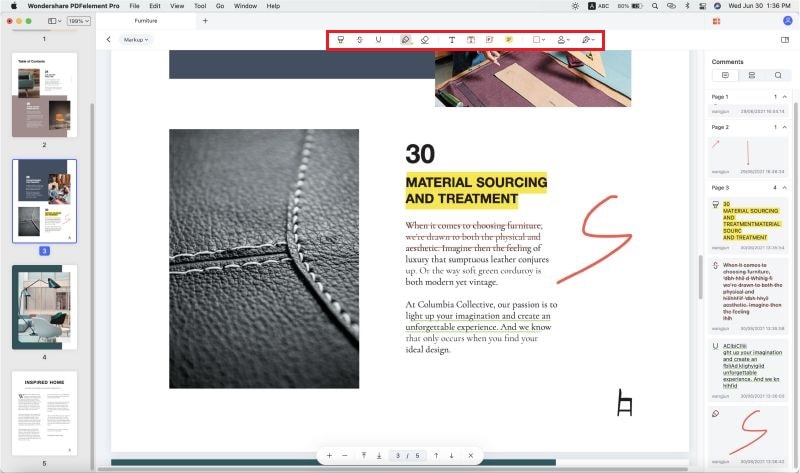
- Text Comment: You can leave a Text Comment to indicate content modification or suggestion.
- Sticky Note: To leave your comments or instructions on the PDF pages, you can use the "Add Sticky Note" function which can help direct the readers to a specific text area.
- Text Box: The "Text box" option allows you to add an always visible box of text, allowing you to bring attention to important text in the PDF.
- Text Callout: It is often used to add a specific note in a PDF page, or indicate an important aspect of the document.
2Properties for Comments
3Delete Comments

Stamps
1Built-in Stamp
-
Clicking the "Markup" button will enable more tools for use. Click the "Stamps" option, you can click a built-in stamp to add in the PDF page where you need.
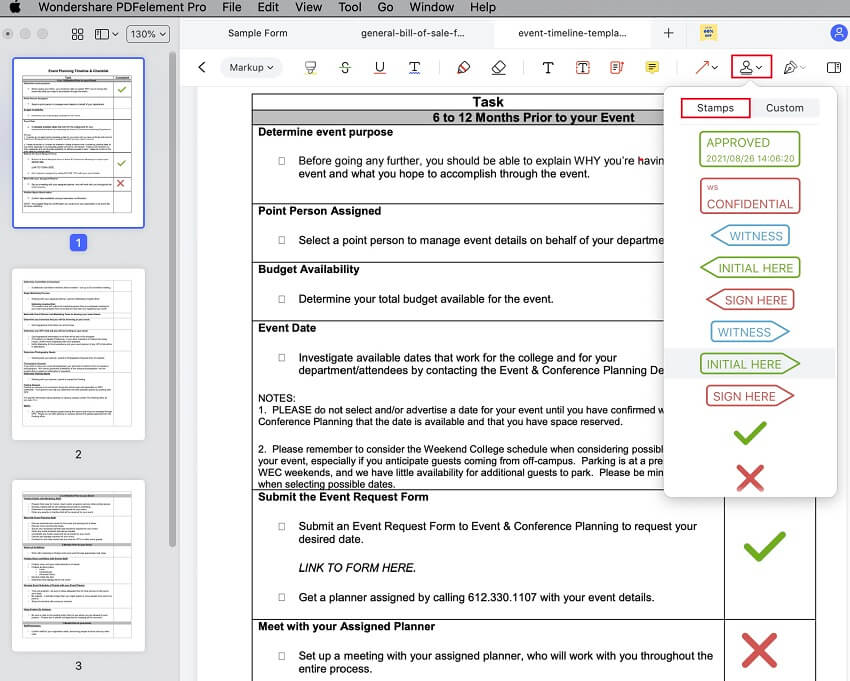
- Click and select your built-in stamp. Place the mouse cursor on one of the eight blue boxes on the edge of the stamp to allow for resizing through dragging in the direction needed. It’s also possible to drag the stamp by clicking and holding on it, or by using the arrow keys for precise movements.
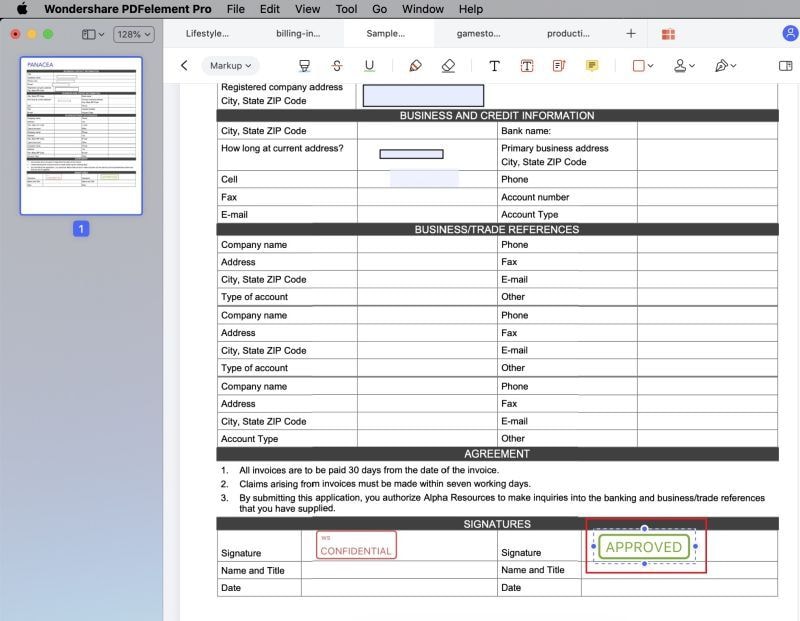
2Signature

Video of How to Sign PDF
Shapes
1Add Drawing Shapes to PDF
- Click the "Markup" > "Shapes" > "Shape/Line Tool" button, select the shape that you need on the panel.
- Click the PDF page where you wish to add the shape and drag to draw an arrow or line.
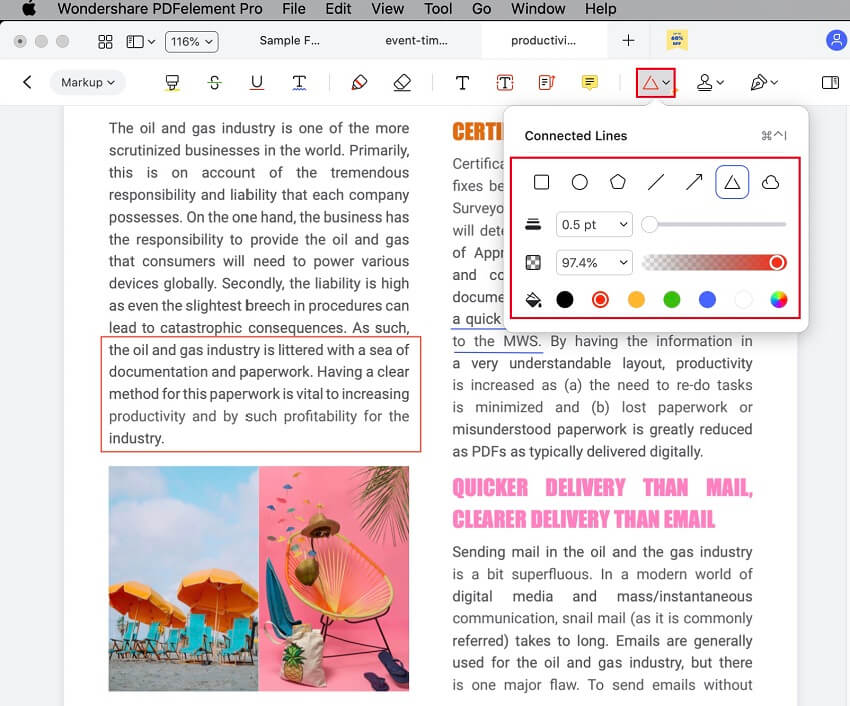
- Rectangle: A proofreading symbol used to indicate where something is to be inserted in the document.
- Oval: To draw an oval or a circle.
- Line: To mark with a line.
- Arrow: An option to give a direction that a specific annotation is meant to be attached to.
- Polygon: To draw a closed plane figure bounded by three or more lines segments.
- Connected Lines: To draw an open plan figure with three or more line segments.
3Use Pencil And Eraser Tools
- Go to the "Markup" menu in the toolbar, select the "Pencil" tool.
- Click and drag the pointer on the PDF to create the image that you need.
- If modifications need to be made to the drawing after finalizing it, click on the "Eraser" tool to erase the section that needs adjustment.
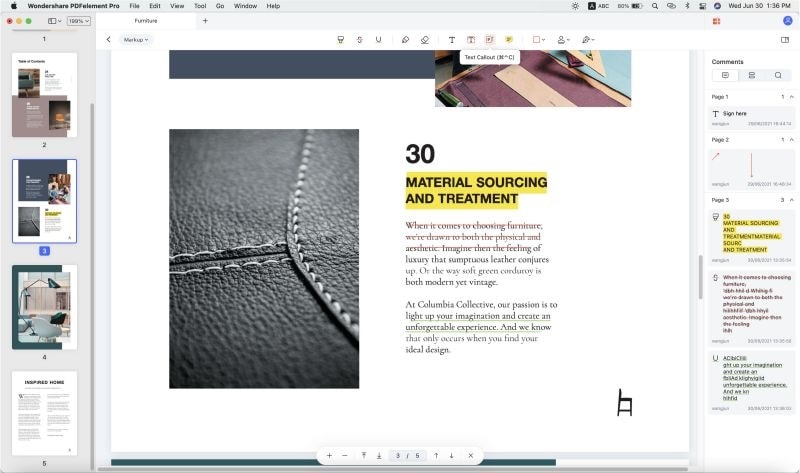
Fill in Forms
1Fill Interactive Forms
- To fill in an interactive PDF form, open the form within PDFelement for Mac.
- Click on the fillable fields or boxes to input text.
- Click "File>Save" or press Command+S keys to save the electronic form into a local folder.
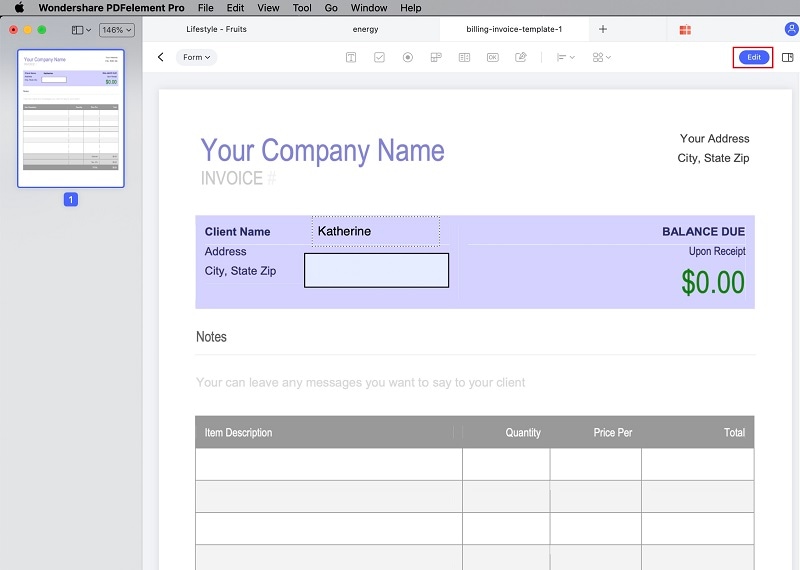
2Fill Non-interactive Forms
Video of How to Fill out a PDF Form
Create Interactive Forms Manually
(Only available in PDFelement Pro for Mac version)
- Text Field: Text filed is used for inputting information allowing for both alpha and numeric values to be included.
- Check Box: Check boxes allow for multiple selections to be chosen from a list of options given.
- Radio Button: Radio Buttons are also used for making selection, except for that only one selection is allowed to be checked. Once one of the radio buttons is selected, the remaining buttons will turn to grey and be non-selectable.
- Dropdown: A Dropdown is used to supply a list that can be accessed by clicking on the downward-facing arrow. Once the list has been expanded, a single item can be chosen from the list to fill in the specific field.
- List Box: List Boxes appear with a scroll bar and the list is able to be scrolled for selection by using the mouse. List Boxes appear with a scroll bar that allows them to find a selection by scrolling through a pre-defined list with the mouse. If more than one option from the list is needed, just press the Command key while selecting.
- Button: Buttons are used for triggering an action, such as submitting the form or resetting the form.
1Add Text Field
- Click the "Form" menu on the left toolbar.
- Select the "Text Field" icon to and then choose the location in the document that you need to add a text field element. The text field will be labeled as "Text Field" by default.
- Double-clicking on the text field or click the "Show Field Properties" button on the top side panel to activate the properties window which allows for modification.
- In the "General" option, you are able to alter the name of the field.
- The "Options" option allows you to set the alignment mode for the text, and also add in a "Default Value" for the text box if you need it.
- Create a field for Password entry or file selection.
- Selecting "Multi-line" or "Scroll long text" options will allow for multiple lines to be entered and also allow for a scroll option to be added to the text field allowing for extra visibility.
- You can also set a limitation of the number of characters allowed in the text field by clicking "Limit of characters".
- Check the "Comb of characters" to build a comb filed which is meant for typing characters in independent boxes. You can define the character numbers. Please note that this option is incompatible with other options.
- If you need to alter the boxes appearance that can be completed through the "Appearance" option.
- To format the text field, select a format category from the "Format".
- If the data in the text field is for calculation, check the calculate option and define the existing fields in which the data will be calculated by clicking the "Pick" button. For example, the following is the property for text field 3 on the PDF, and after settings this, it will calculate textfield3=textfield2+textfield1.2.1. This means that when you input data in textfield2 and textfield1.2.1, textfield3 will get the sum result automatically.
- Choose the actions and triggering mode for the text field in the "Actions" tab.
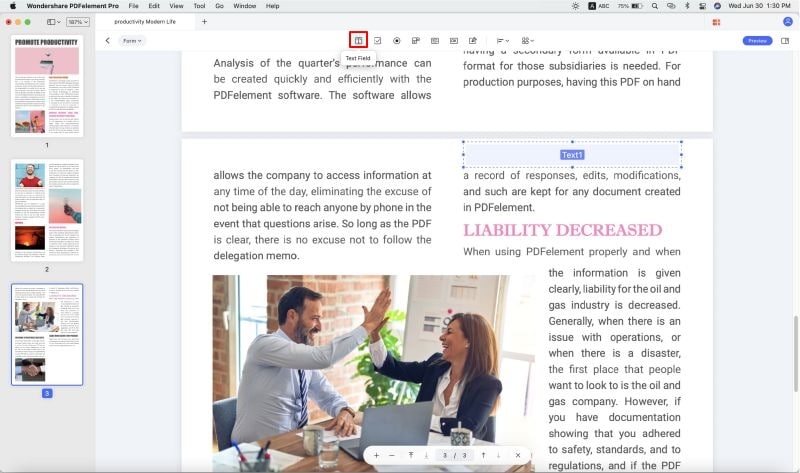
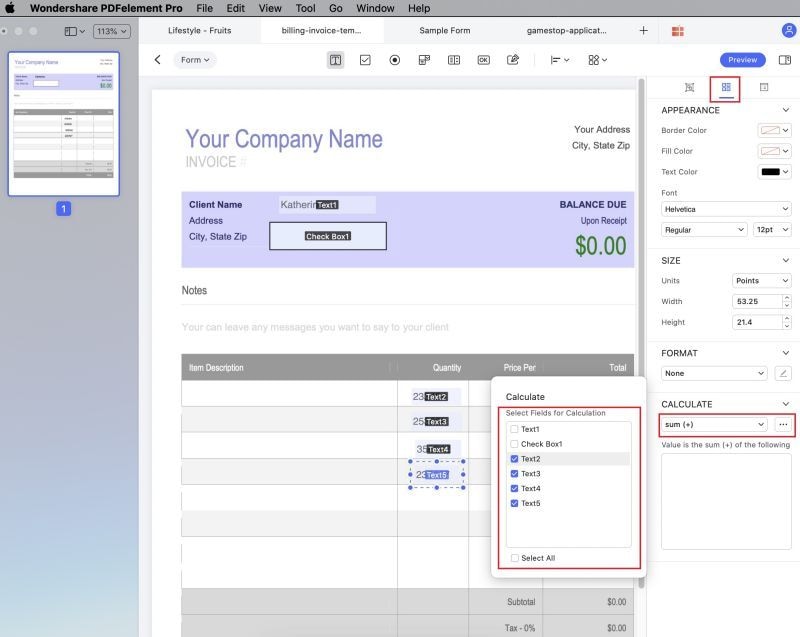
3Add Check Box
- Under the "Form" tab, click the "Check Box" icon, and drag the mouse to the place that you require the check box.
- Double-click on the check box, and define its name, appearance as needed.
- In the "Options", you can pick the check box style and modify the export value.
- Choose the triggering actions for the check box in the "Action".
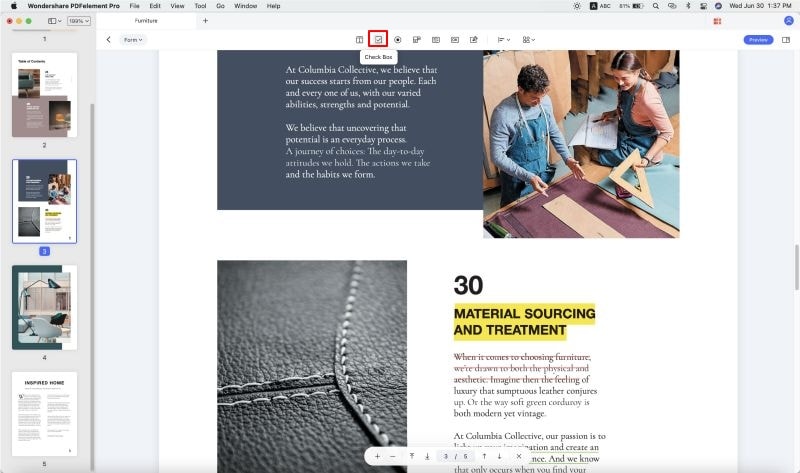
4Add Radio Button
- To add a radio button, select the radio button icon under the "Form", click on the PDF page.
- Double-click the radio button, and set the name and appearance for it in the "General" and "Appearance".
- Select the button style under the "Options".
- If you want all radio buttons checked when one button is selected, check the option of "Button with the same name and choice are selected in unison".
- Modify the actions for the radio button in the "Actions" tab.
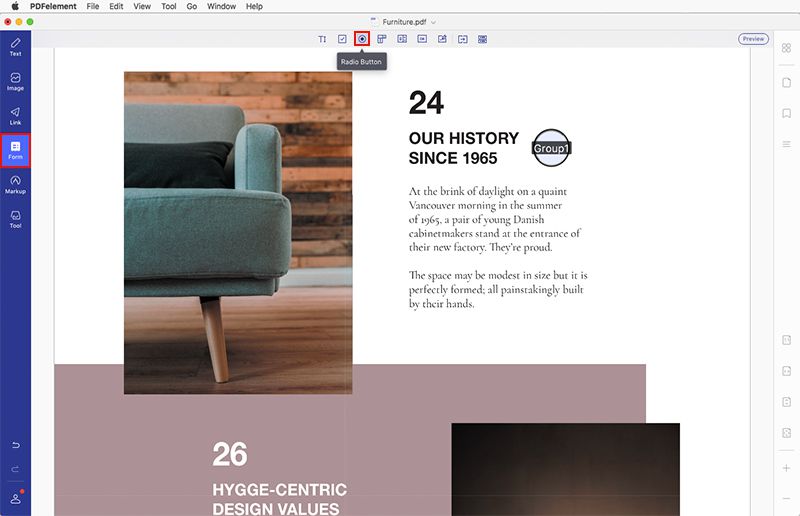
5Add Dropdown
- Under the "Form" tab, click the "Dropdown" icon.
- On the PDF page move your mouse cursor to where you need to input the field.
- Double-click the field, type the name in the "General", and modify the appearance in the "Appearance" option.
- In the "Options" tab, add an item and enter an export value in the Export Value text box. Repeat this step until you have all of the items that you need listed.
- Check the "Sort items" option if you want all the items stored by alphabetical order. To manually reorder the items, choose the item, and click the "Up/Down" buttons. If you want to remove an item, select it and click the "Remove" button.
- If you are looking to have the information submitted by the user, check the "Allow user to enter custom text" option.
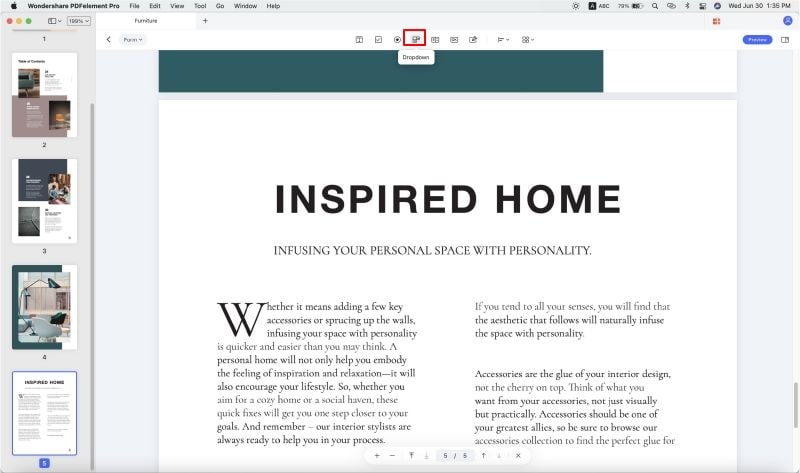
6Add List Box
- In the "Option" window, name the new item that you are including and then include an export value into the "Export Value" field.
- You can arrange the items by alphabetic order by clicking "Sort items".
- If you want the respondent to select multiple items, check the "Multiple selection" option. If multiple items are able to be chosen, select the "Multiple selection" option.
- Create actions for the list box field in the "Action" window.
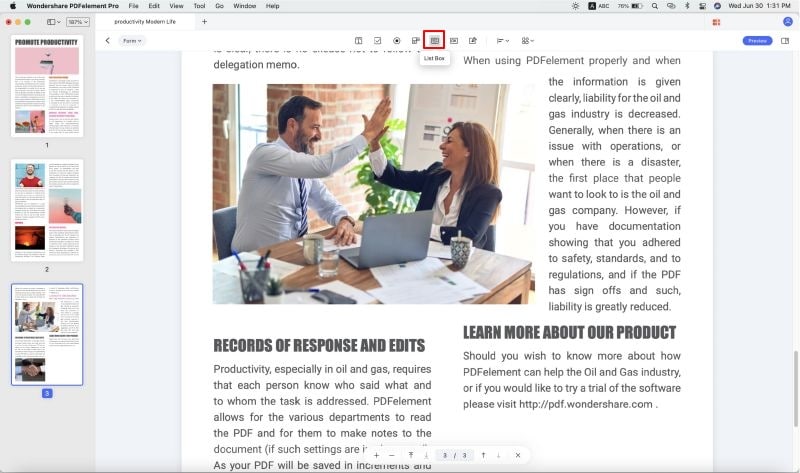
7Add Button
- Click the "Button" icon under the "Form" tab.
- Move your cursor to the location in the PDF page and add the button by clicking on the chosen location.
- Double-click the button field, name it, and modify the appearance.
- In the "Options" part, you can define the button layout. Choose your preferred icon from the local folder and give it a label in the Labe text box, and then select the button layout as well as the behavior.
- Customize the actions for the button field in the "Actions" window.
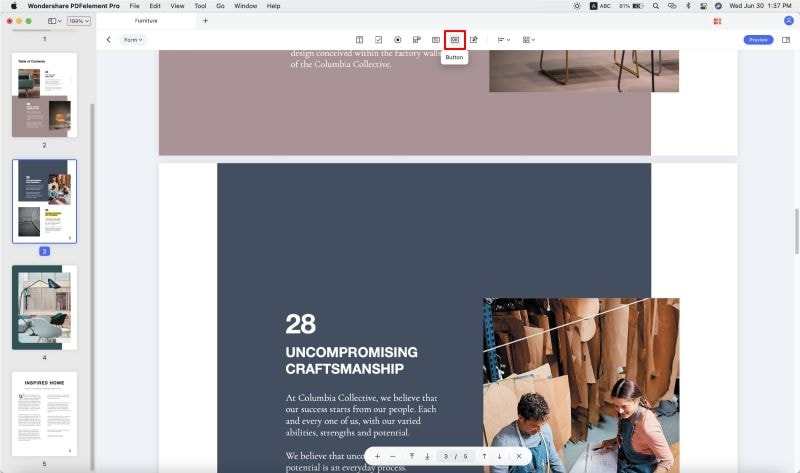
Video of How to Create Fillable PDF Forms
Create Interactive Forms Automatically
(Only available in PDFelement Pro for Mac version)
- PDFelement Pro supports to create interactive forms automatically with one click, which can dramatically improve your efficiency. If you have a non-interactive PDF form containing blank lines and tables, the document is not a fillable form and will not be useable.
- After opening it in our program, you can click the "Form" button, then click the "Form Field Recognition" button to recognize the blanks and tables automatically, then you will get the fillable fields created. All the corresponding types of form fields will be automatically named with the text near the form fields.
- Click the "Preview" button in the toolbar, then place the cursor in the field that you wish to fill in, and enter the information requested.
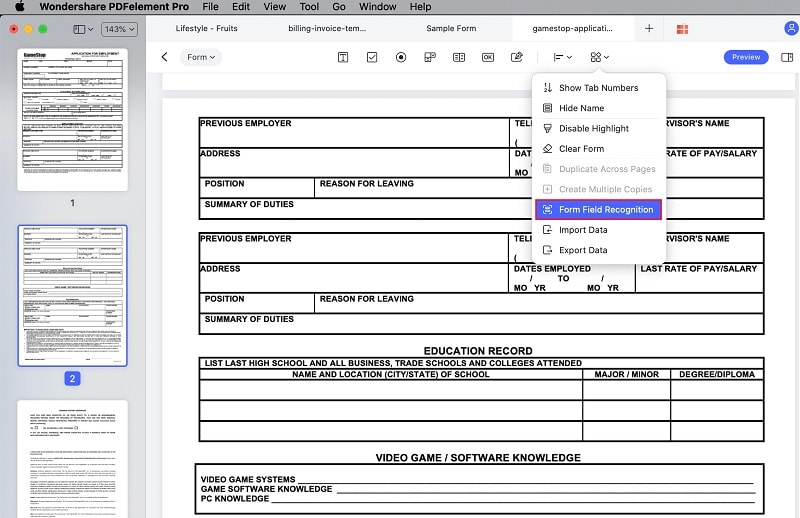

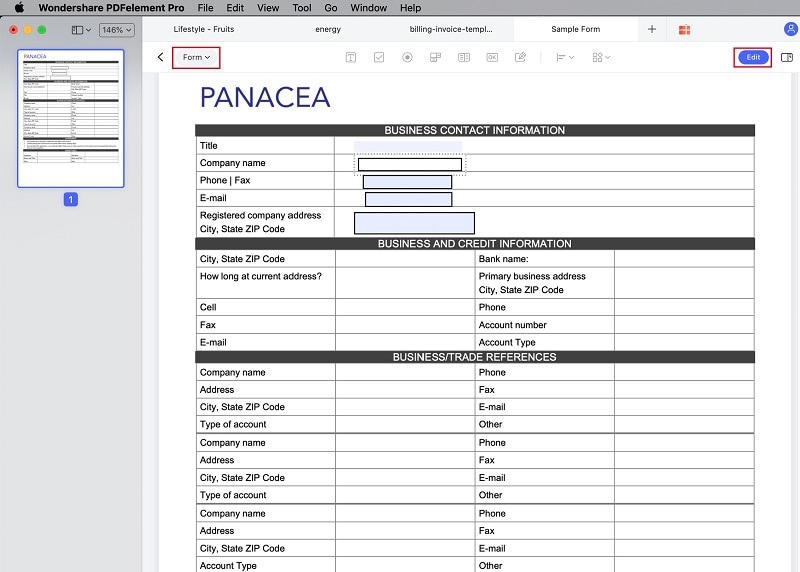
Video of How to Recognize PDF Form Fields
Form Alignment
(Only available in PDFelement Pro for Mac version)
- After opening the PDF file with the interactive forms, please click the "Align" button.
- Hold the Command key to click multiple fields to select them at the same time.
- Click the "Align" or "Distribute" options to align.
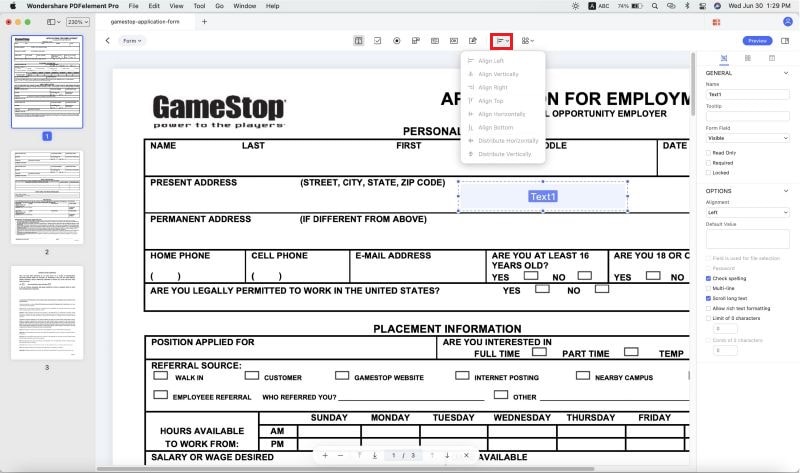
Supported Output Formats
- PDF to Word: Convert PDF to Microsoft Word (.doc & .docx)
- PDF to Excel: Convert PDF to Microsoft Excel (.xls & .xlsx)
- PDF to PPT: Convert PDF to Microsoft PowerPoint (.pptx)
- PDF to Images: Convert PDF to Word Processing (.jpg, .JEPG, .BMP, .TIFF, .GIF) format
- PDF to Epub: Convert PDF to Electrical Publication format (.epub)
- PDF to Text: Convert PDF to Text (.txt) format
- PDF to HTML: Convert PDF to Hyper Text Markup Language format
- PDF to RTF: Convert PDF to Rich Text format (.rtf)
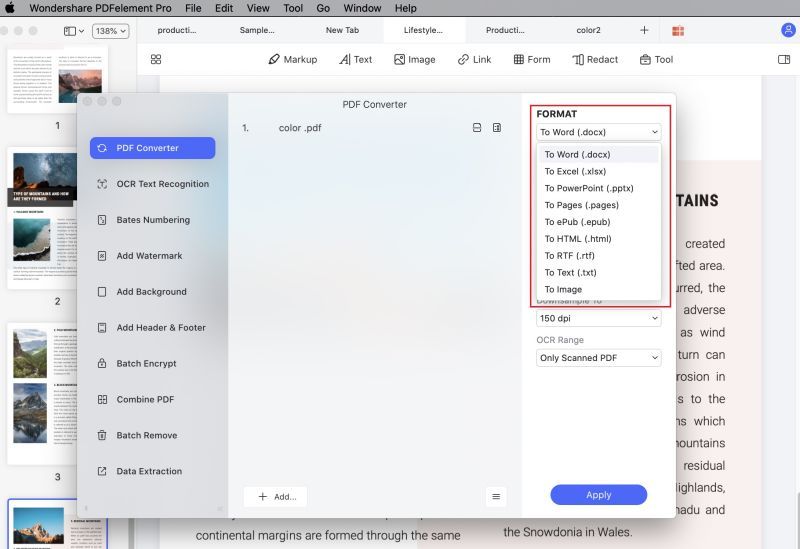
Convert PDF
1Convert a Single PDF
- After opening the PDF file in the program, click the "File" > "Export To" button in the toolbar.
- Choose "Word" or another output format as needed.
- Choose the output folder where you want to save the file, and start the process.
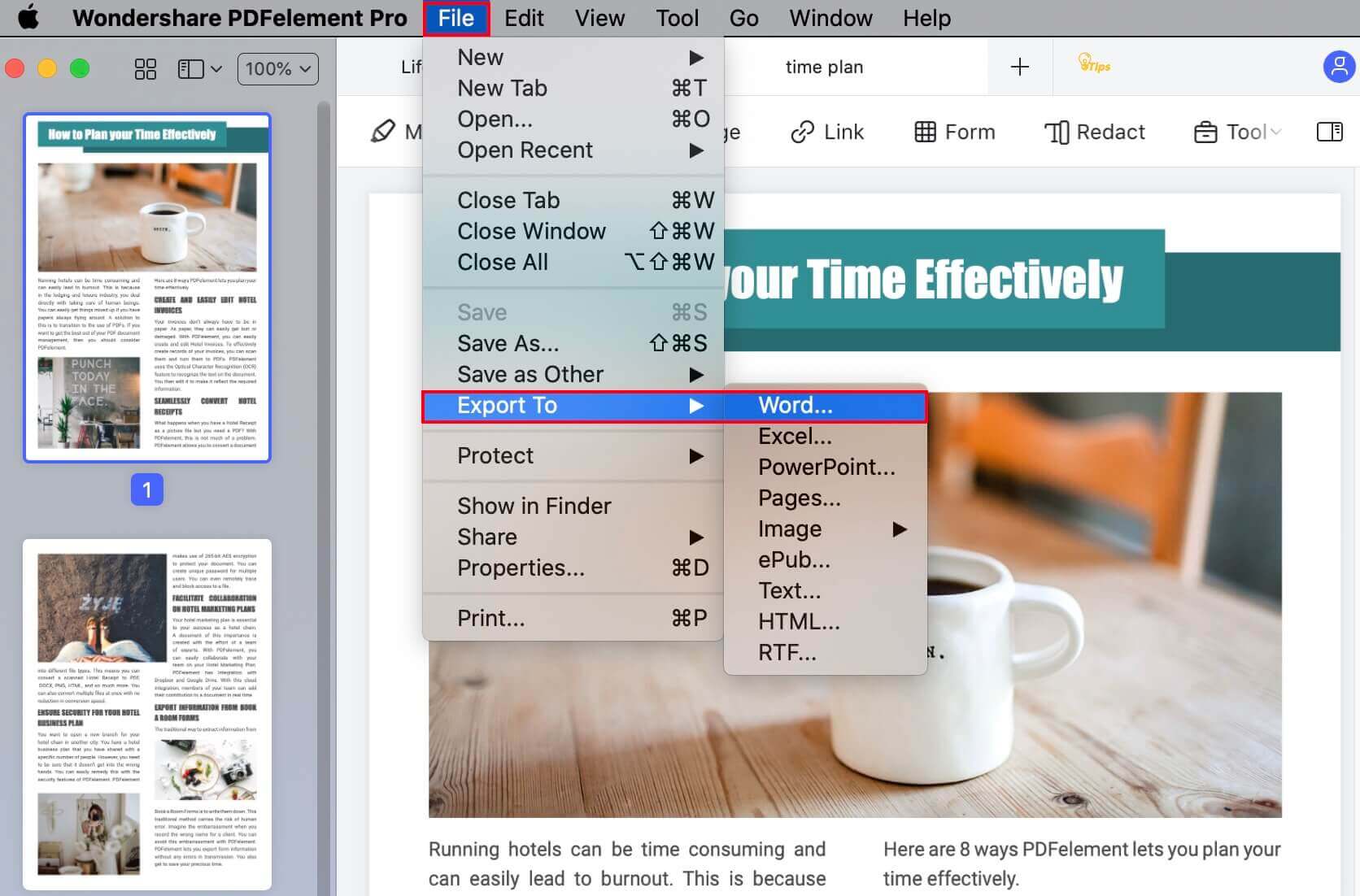
2Convert a Batch of PDFs
(Only available in PDFelement Pro for Mac version)
- After opening the program and open one file, click the "Tool" > "Batch Process" > "PDF Converter".
- Select the PDF files to add to the program.
- Choose the "Format" on the right-side panel. If your file is an OCR file, you can select OCR settings and choose a language.
- Click the "Apply" button to start the process.
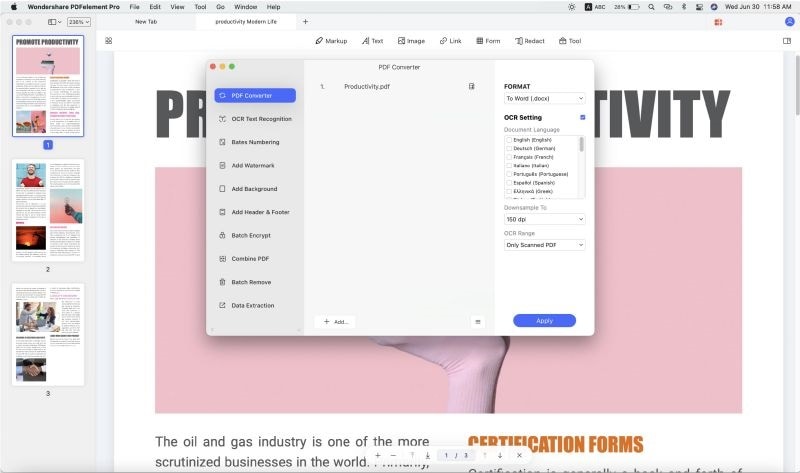
Video of Converting PDF to Image
Convert Scanned PDFs to Editable Files
(Only available in PDFelement Pro for Mac version)
- After opening the scanned PDF files in the program window, please click the "Tool" > "Batch Process" > "OCR Text Recognition" button, then choose the output format as needed.
- Choose your document language and type.
- Click the "Apply" button, and then choose an output folder to start the conversion.
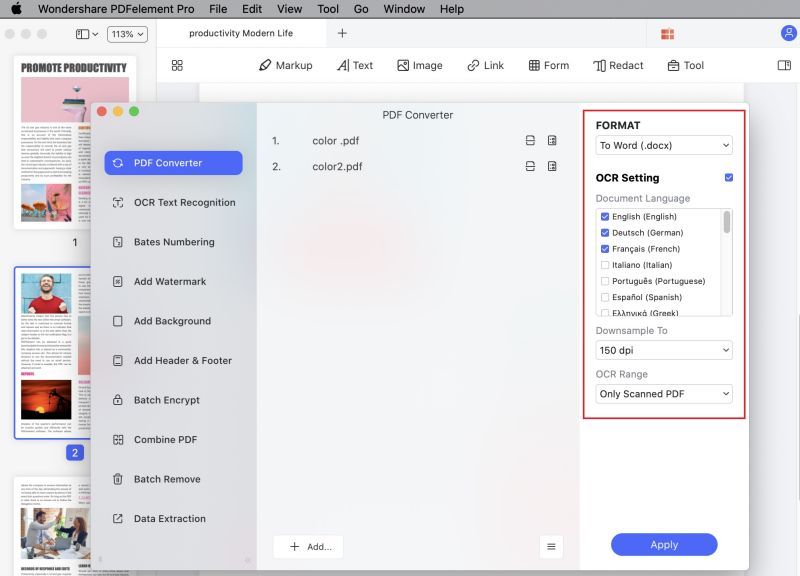
Convert to PDF/A(Only available in PDFelement Pro version)
- After editing or working with your PDF file in the program, or created a PDF file in the program, please click the "File" menu on the top.
- Choose "Save As Other">"Archivable PDF(PDF/A) to save it directly.
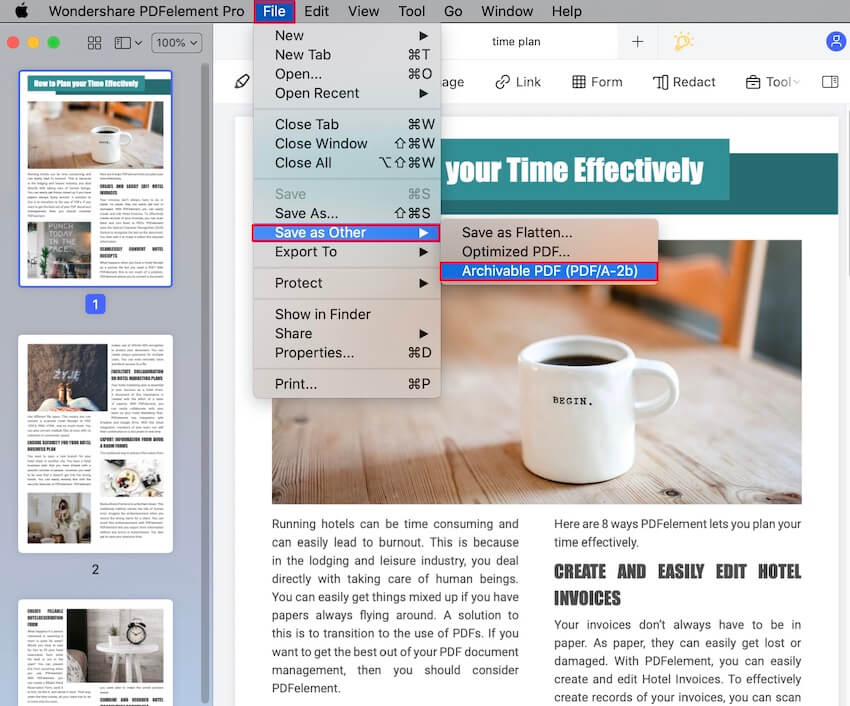
Password and Permissions
1Encrypt with Password
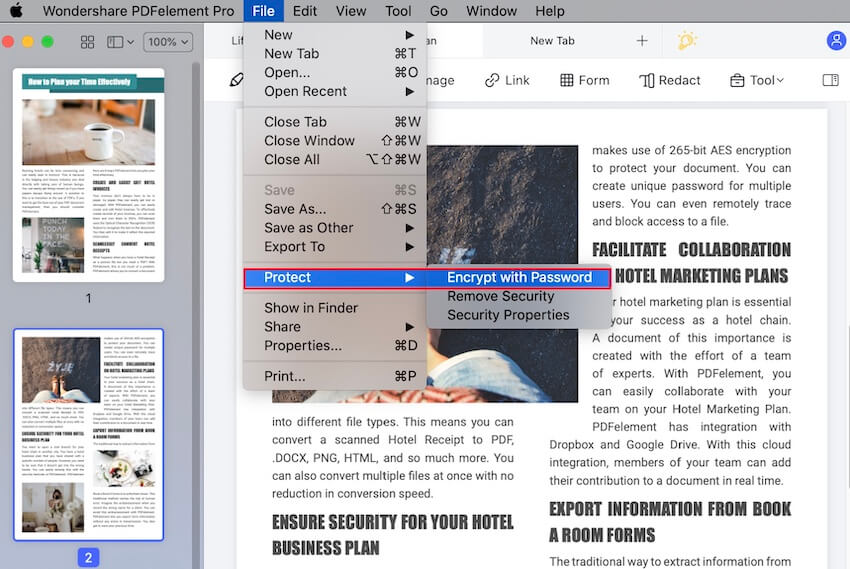
- After opening the PDF file in the program, please click the "File" > "Protect" > "Encrypt with Password" button.
- In the pop-up Security Settings window, you can choose to set the security. Note: As there is no way to recover or open the document if the password is lost/forgotten, be sure to use one that you will remember.
- Printing Allowed: Set permission for printing the document, and at what resolution quality.
- Changes Allowed: Customize permissions for the modifications that can be made to the current PDF document. Steps to create a permission password are as below:
- Enter the permission password. You can customize the encryption level by adding complex password groups. The higher the encryption level, the more difficult it is to crack the password.
- Click the "OK" button to set the password and finally don't forget to save the document.
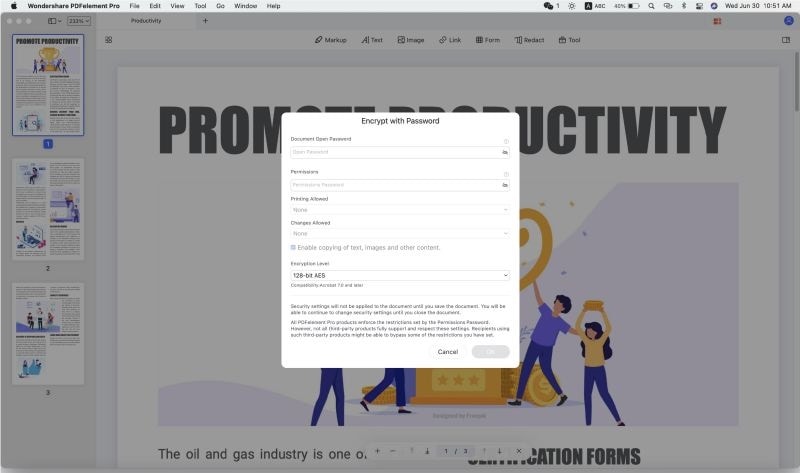
2Remove Security
- Open the "file" > "Protect" menu. Then click the "Remove Security" button.
- There will be a pop-up window asking you to enter the permission password. Without that password, you will not be able to remove the security, thus be sure to remember the password used on that document.
- Click to save the document.
3Check PDF Permissions
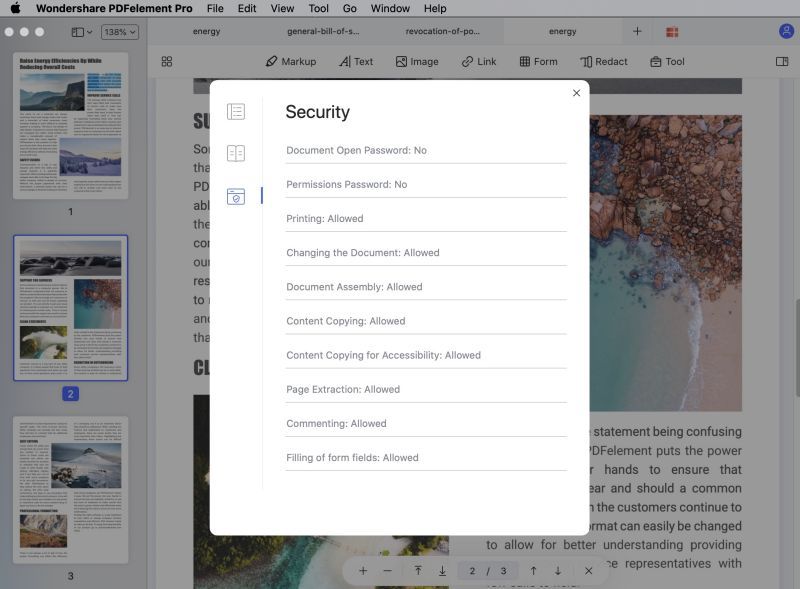
4Batch Encrypt
(Only available in PDFelement Pro for Mac version)
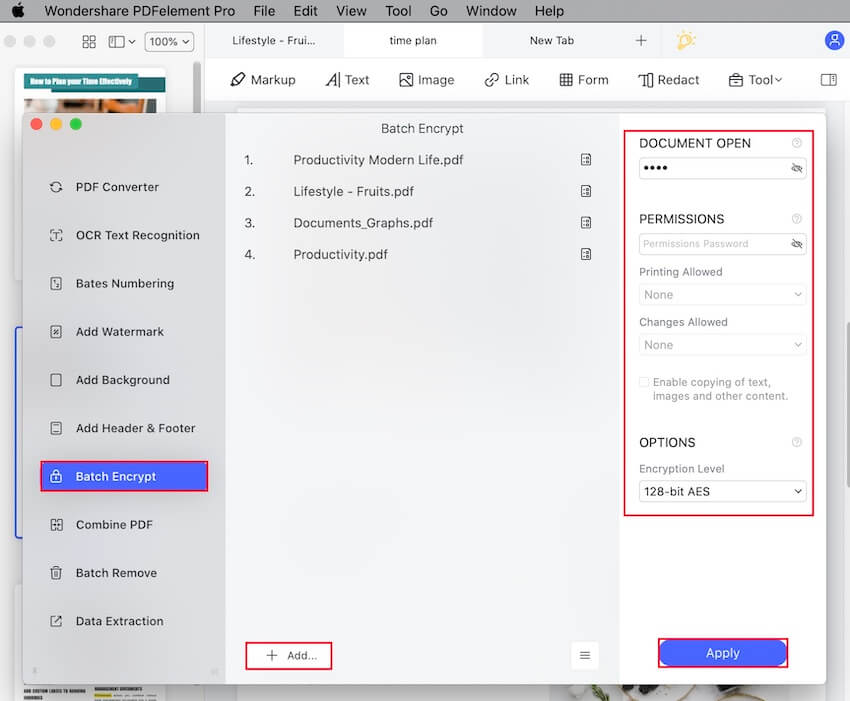
Video of How to Encrypt PDFs
Digital Signatures
-
You can use our PDFelement Pro for Mac to create a digital signature field by clicking the "Form">"Digital Signatures" button, then send the PDF file to others to add digital signatures.

-
Or you can also use our program to add the digital signatures directly. After adding a digital signature field, please click the "Preview" button, then click the "Sign Here" symbol.
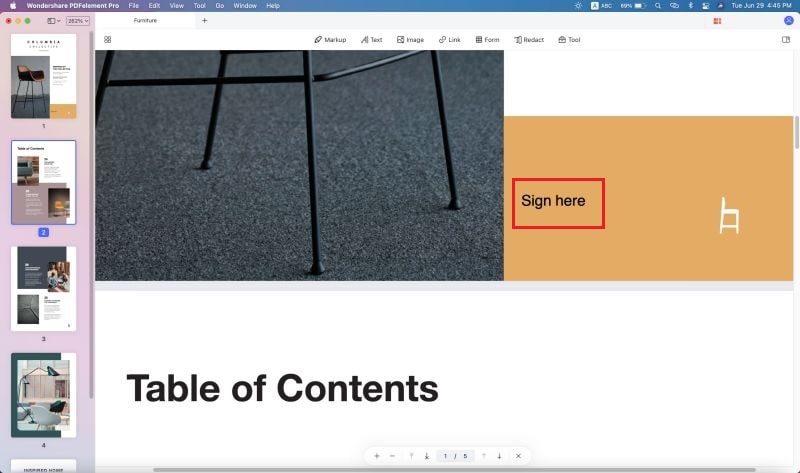
- In the pop-up window, choose a digital ID as you want to sign. If you do not have any ID yet, please click the "Create" button to create one.
-
In the pop-up windows, enter the Identity information to be used for creating the self - signed Digital ID.
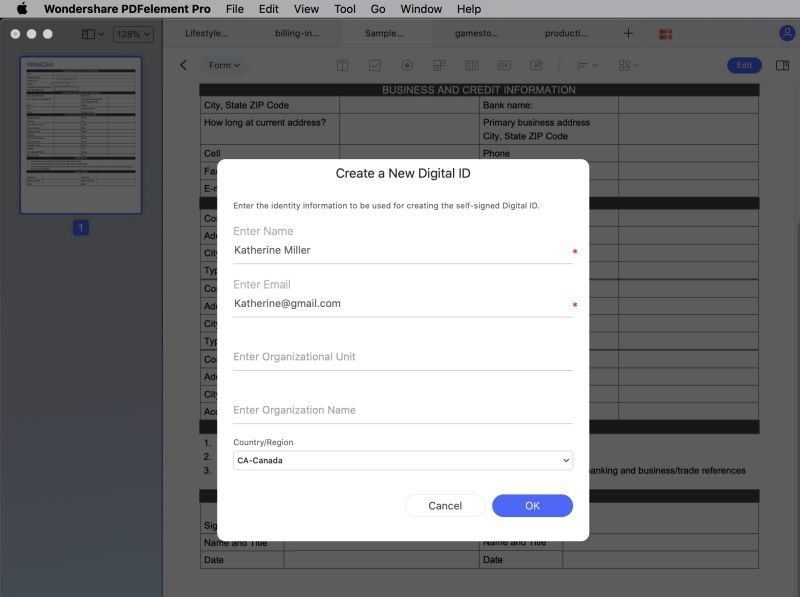
-
Click the "OK" button.
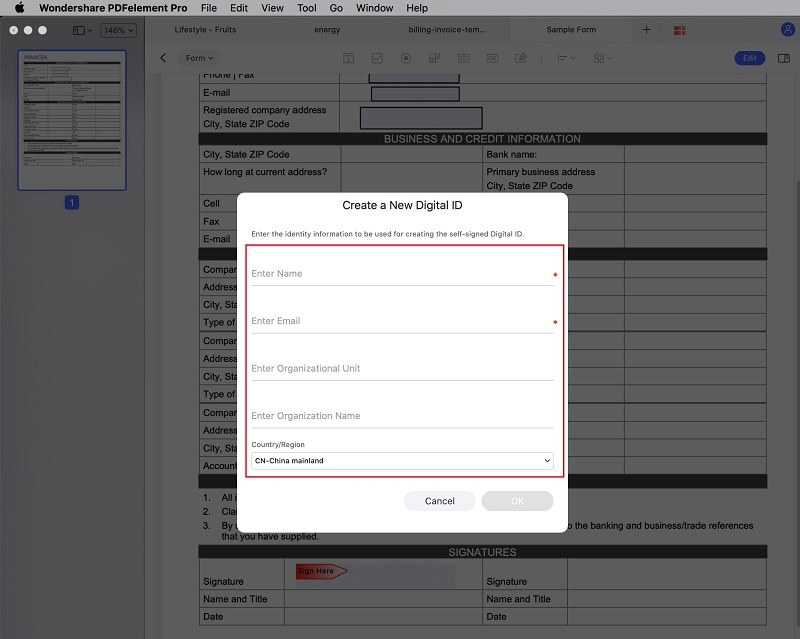
-
It will go back to the first "Sign Document" window and you can preview your digital signature. You can also click the "Create" button under the Appearance to change the style of your Digital signature.
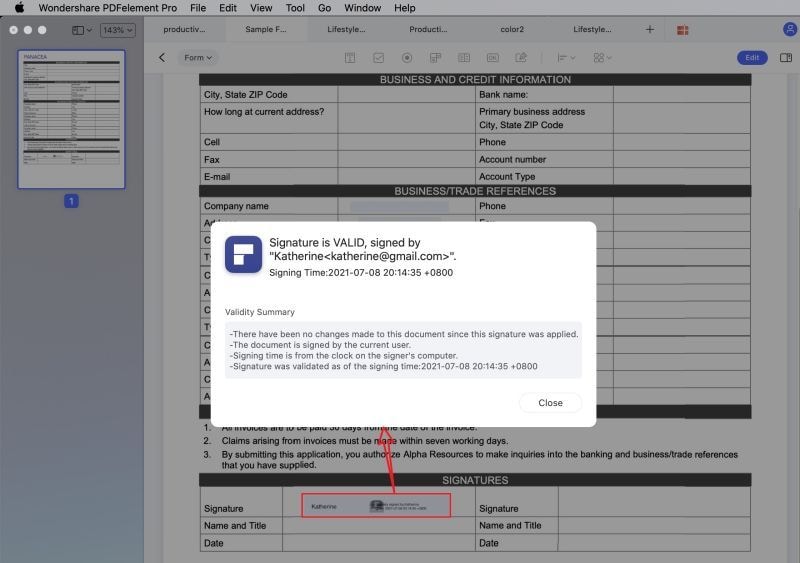
-
Click the "Sign" button and save your file, the digital signature will be applied in it directly.
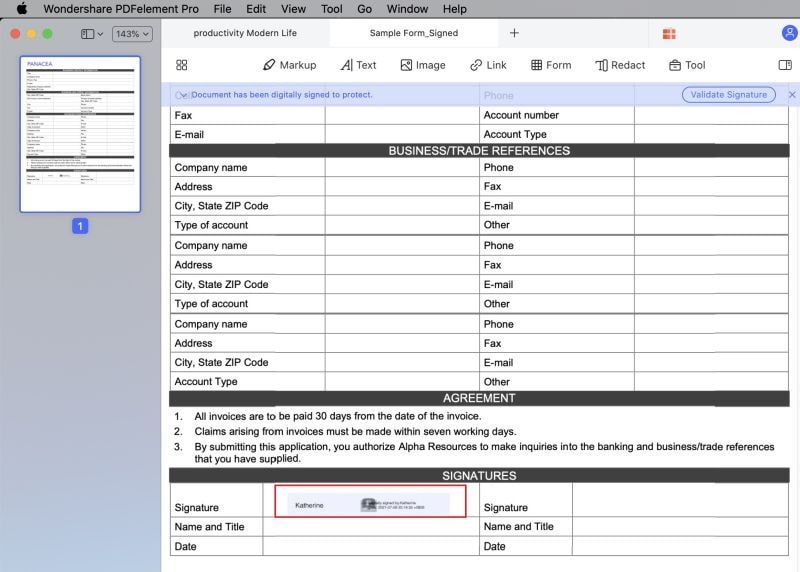
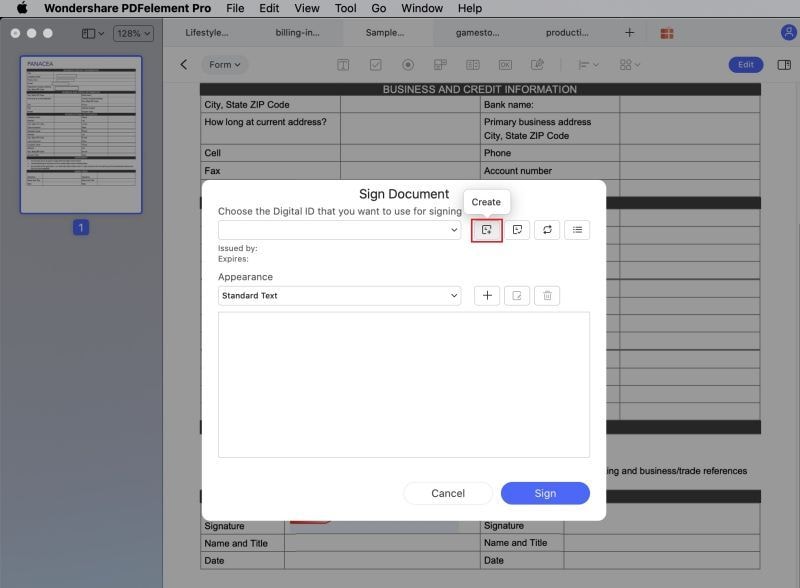
Video of Combining PDF Files
Redaction
-
Launch the program, and click the "Open File" button at the bottom of the screen. Then you can select the PDF that you want to protect through redaction. Once you've done this, click on the "Open" button.

- Now you can redact text, images, and pages on your PDF by clicking the "Redact" button.
- To redact text and images, you can click on the "Text & Image" button and then drag the cursor to highlight the desired text or images. Once you release your mouse, the item will be automatically blacked out.
- To redact pages, you can click on the "Pages" button on the top. Then a new window will pop up, and you can select the page range that you want to redact.
-
After selecting the content that you want to redact, click the "Apply" button on the top-right corner. Then the selected content will be removed permanently.

-
You can also edit the redaction properties. After clicking on the "Redact" button, you can select a preferred color on the top. You can test the changes by redacting parts of the PDF file.
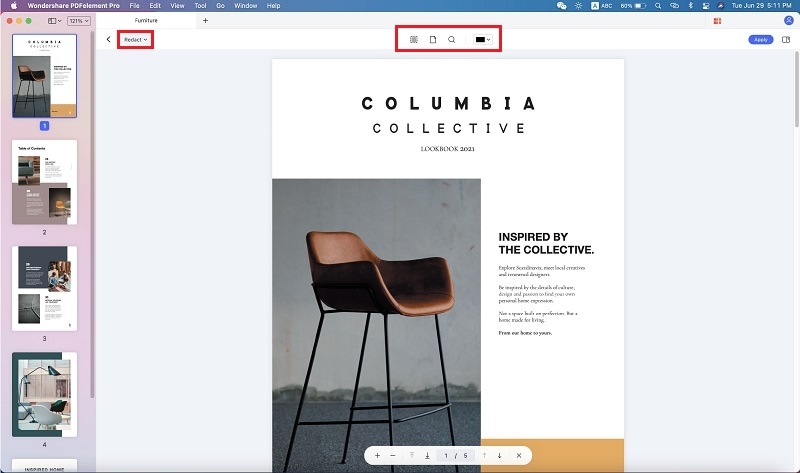
Video of Redacting PDF
Optimize PDF
(Only available in PDFelement Pro for Mac version)
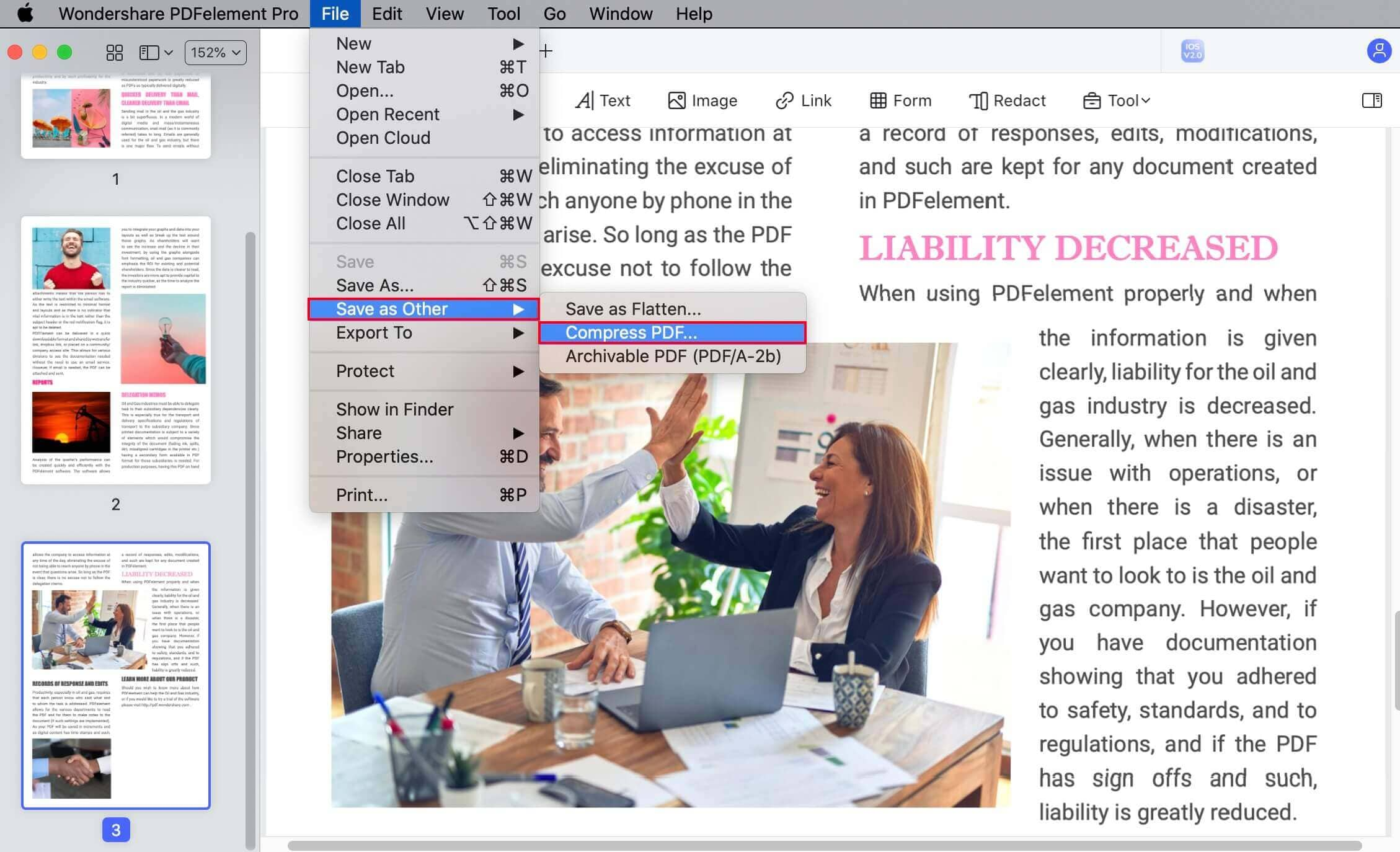
- Move to the top header bar and click the "File" menu.
- Click the "Save as Other" > "Optimize PDF" button from the drop-down menu.
- Choose an ideal compression quality to preview and then save the optimized file in a local folder as you want.
Video of How to Compress a PDF
Print Options
- Click the "File">"Print" button on the toolbar or hit "Command + P" on the keyboards to activate the print command window.
- In the pop-up Print window, you will be able to choose the printer, set the copies you need to print and customize the pages. You will be shown a preview of how the printed document will appear.
- In "Show details", you can choose the paper size, orientation, Boarder, etc.
- After the settings, click "Print" and then you will get the paper copy.

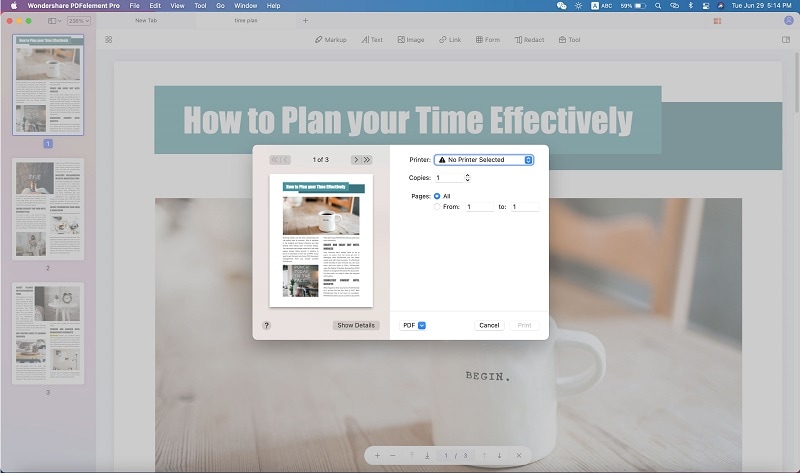
Video of Printing PDF
Print Properties
- Printer: Choose the printer that is connected to your Mac.
- Copies: Enter the copy number for output papers.
- Pages: Choose All or customize the page range.
- Page Size: Select the appropriate page size for the current PDF files, like A4, A5, or US Letter, etc.
- Orientation: Choose to print in Portrait or Landscape, and select the Scale percentage as needed.
- Pages to Print Choose the pages you need to print.
- Page order Choose the page order to print according to your need.
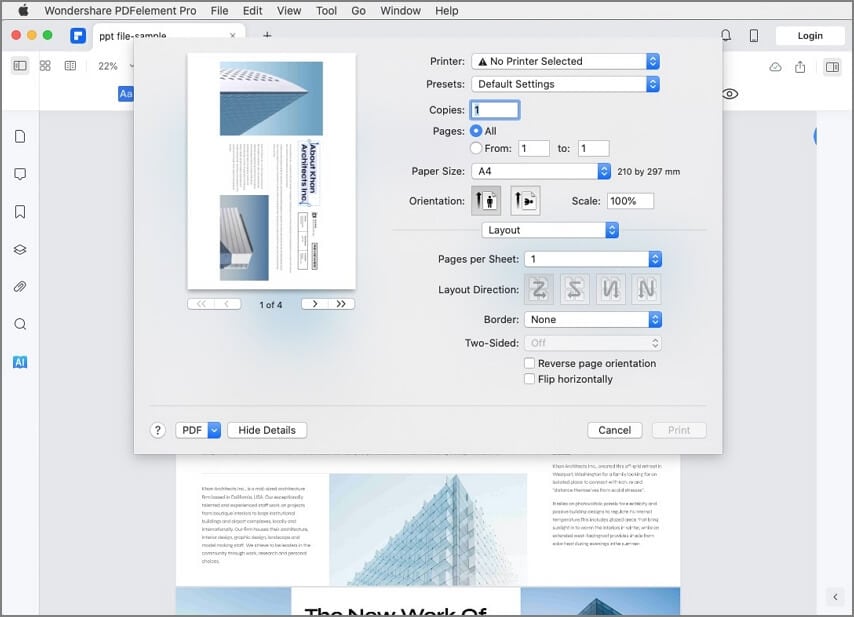
Email Attachment
- Please click to the "File" > "Share" > "Mail" button. Then log in to your email account.
- After that, the current file will be attached to an email draft.
- You can then send your PDF file via email within the application.

Messages
- Go to "File" > "Share" > "Messages" on the top menu, you can share your file with others via messages.

AirDrop
- Go to "File" > "Share" > "AirDrop" on the top menu, you can share your file to someone using a Mac, and ask them to go to AirDrop in the Finder.
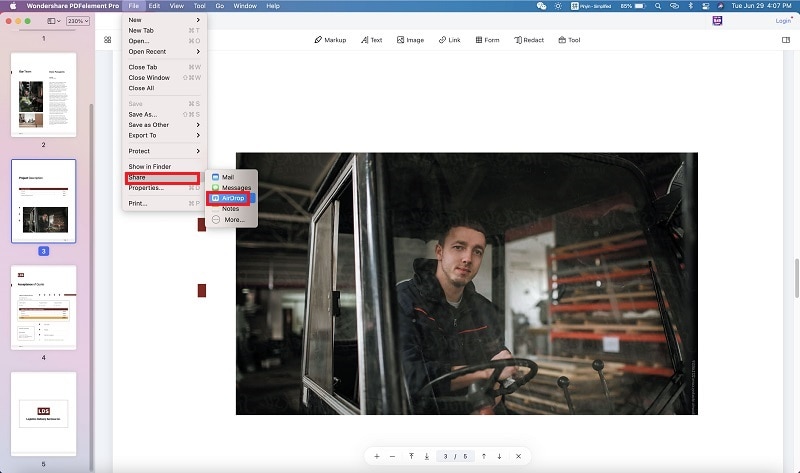
Notes
- Go to "File" > "Share" > "Notes" on the top menu, you can save your file in your Notes.

Add People
- Go to "File" > "Share" > "Add People" on the top menu, you can choose the people who can make changes.
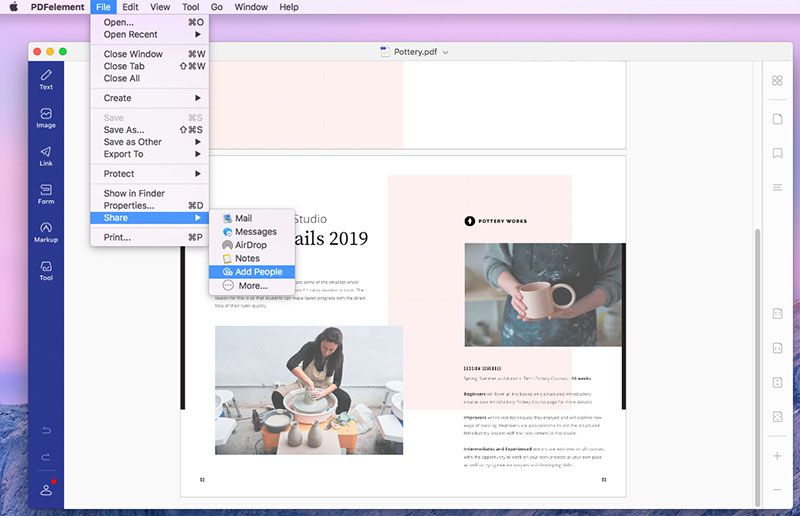
PDFelement for Mac User Guide
We have something for you in using PDFelement more easily.